30 Best Destinations in Central America for Solo Travelers
Table of Contents
ToggleCentral America is a treasure trove of adventure, culture, and natural beauty, making it an ideal destination for solo travelers. Whether you’re an experienced backpacker or a first-time traveler, there’s something for everyone in this region.
From the stunning colonial towns of Antigua and Granada to the pristine beaches of Roatán and Tulum, and the ancient ruins of Copán and Tikal, Central America has it all.
Here are the 30 best destinations in Central America for solo travelers, each offering a unique and unforgettable experience. So, pack your bags, grab your passport, and get ready for an adventure of a lifetime in Central America!
1. Antigua, Guatemala – Colonial Charm & Volcanoes.

Antigua is a stunning colonial town located in southern Guatemala, surrounded by three majestic volcanoes. This charming city is known for its vibrant culture, rich history, and stunning architecture, making it a must-visit destination for solo travelers.
Location: Antigua is located in the central highlands of Guatemala, about 45 minutes from the capital city of Guatemala City. The town is situated at an elevation of 1,500 meters (4,900 feet) above sea level and is surrounded by the Agua, Fuego, and Acatenango volcanoes.
Known for: Antigua is known for its stunning colonial architecture, colorful markets, and vibrant nightlife. The town is also a popular destination for those seeking outdoor adventure, with opportunities for hiking, mountain biking, and volcano climbing.
The Best Mode of Transportation: Antigua is a walkable city, and most of the attractions are located within a few blocks of the central square. However, if you need to travel further, you can take a tuk-tuk or a taxi. Buses are also available for travel to other towns and cities in Guatemala.
Daily Budget: The daily budget for a solo traveler in Antigua can range from $20-$50 USD per day, depending on your accommodation and dining preferences.
Hostels and budget hotels are available for around $10-$20 USD per night, while mid-range hotels can cost around $40-$60 USD per night.
Food and drinks are generally inexpensive, with local street food starting at around $1-$2 USD.
Culture: Antigua is a UNESCO World Heritage Site and has a rich cultural history. The town is known for its Spanish Baroque-style architecture and is home to many museums and art galleries.
Antigua is also known for its colorful markets, where you can find handmade crafts, textiles, and souvenirs.
Nightlife: Antigua has a vibrant nightlife, with many bars and clubs located in the town center. Some popular spots for nightlife include Cafe No Se, which offers live music and mezcal tastings, and Las Vibras de la Casbah, which has a rooftop bar with stunning views of the town.
Food: Antigua is known for its delicious cuisine, with many local dishes featuring ingredients like black beans, rice, and plantains. Some popular dishes to try include pepián, a traditional meat stew, and chiles rellenos, stuffed peppers.
There are also many international restaurants and cafes in Antigua, offering everything from pizza to sushi.
Safety Measures: Antigua is generally a safe destination for solo travelers, but it’s important to take precautions like avoiding walking alone at night and keeping your valuables secure. It’s also recommended to drink bottled water and to be aware of your surroundings.
Attractions: Antigua is home to many beautiful attractions, including the stunning colonial architecture of La Merced Church and the famous Santa Catalina Arch.
The town also has many museums and art galleries, such as the Casa Santo Domingo Museum and the Nim Po’t Textile Museum. Outdoor enthusiasts will enjoy hiking the Pacaya Volcano or visiting the nearby Lake Atitlán.
Some Travel Tips:
- Pack comfortable walking shoes for exploring the town
- Try to learn some basic Spanish phrases to help you communicate with locals
- Take a tour to learn more about the town’s history and culture
- Be sure to try some of the local street food for a true taste of Antigua
If You are planning to visit the USA and looking for the best flight booking from your destination then, So we recommend you book your flight from Qatar Airways or Emirates
2. Granada, Nicaragua – Colorful Town & Lakeside Relaxation.

Granada is a charming colonial town located on the shores of Lake Nicaragua, in western Nicaragua. This colorful town is known for its stunning architecture, vibrant culture, and relaxed atmosphere, making it a perfect destination for solo travelers looking to unwind and soak up some Central American charm.
Location: Granada is located about an hour south of the capital city of Managua, and is situated on the shores of Lake Nicaragua. The town is surrounded by lush tropical forests and is known for its stunning views of the Mombacho Volcano.
Known for: Granada is known for its stunning colonial architecture, colorful buildings, and relaxed pace of life.
The town is also a popular destination for those seeking outdoor adventure, with opportunities for kayaking, hiking, and zip-lining in the nearby forests.
The Best Mode of Transportation:Granada is a walkable town, and most of the attractions are located within a few blocks of the central square. However, if you need to travel further, you can take a tuk-tuk or a taxi. Buses are also available for travel to other towns and cities in Nicaragua.
Daily Budget: The daily budget for a solo traveler in Granada can range from $20-$50 USD per day, depending on your accommodation and dining preferences.
Hostels and budget hotels are available for around $10-$20 USD per night, while mid-range hotels can cost around $40-$60 USD per night. Food and drinks are generally inexpensive, with local street food starting at around $1-$2 USD.
Culture: Granada has a rich cultural history, with its colorful buildings and stunning architecture showcasing the town’s Spanish colonial past. The town is also home to many museums and galleries, including the Mi Museo de Granada, which showcases Nicaraguan art and history.
Nightlife: Granada has a relaxed nightlife, with many bars and cafes located in the town center. Some popular spots for nightlife include The Garden Cafe, which has live music and a rooftop terrace, and La Hacienda, which offers a range of cocktails and wines.
Food: Granada is known for its delicious cuisine, with many local dishes featuring ingredients like plantains, beans, and rice.
Some popular dishes to try include Gallo pinto, a traditional breakfast dish, and vigorón, a dish made with yucca, pork rind, and cabbage salad. There are also many international restaurants and cafes in Granada, offering everything from sushi to pizza.
Safety Measures: Granada is generally a safe destination for solo travelers, but it’s important to take precautions like avoiding walking alone at night and keeping your valuables secure. It’s also recommended to drink bottled water and to be aware of your surroundings.
Attractions: Granada is home to many beautiful attractions, including the stunning colonial architecture of the Cathedral of Granada and the colorful buildings of Calle La Calzada.
The town is also known for its beautiful Lake Nicaragua, where you can take a boat tour or kayak. Outdoor enthusiasts will enjoy hiking the Mombacho Volcano or visiting the nearby Isletas de Granada.
Some Travel Tips:
- Pack comfortable walking shoes for exploring the town
- Try to learn some basic Spanish phrases to help you communicate with locals
- Take a boat tour of Lake Nicaragua for stunning views of the surrounding area
- Visit the nearby Masaya Volcano National Park for a unique outdoor adventure.
Also, read– Top Famous Places to Visit in Indonesia
3. Roatán, Honduras – Caribbean Paradise & Diving.
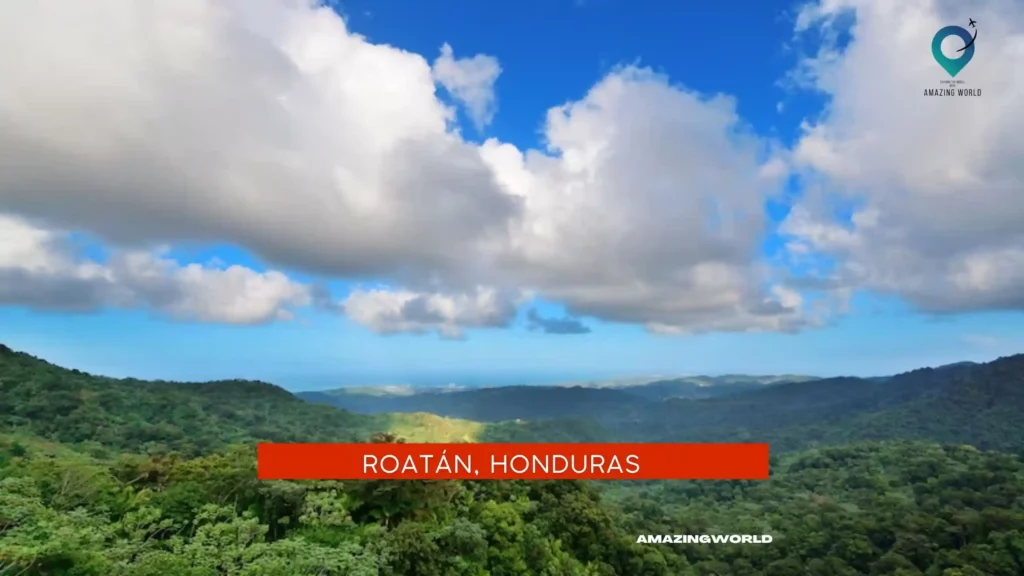
Roatán is a stunning Caribbean Island located off the coast of Honduras. With its white sandy beaches, crystal-clear waters, and vibrant coral reefs, Roatán is a paradise for solo travelers looking to relax, explore, and dive into a world of adventure.
Location: Roatán is located about 30 miles off the northern coast of Honduras, and is the largest of the Bay Islands.
The island is situated on the second-largest barrier reef system in the world, making it a prime location for scuba diving and snorkeling.
Known for: Roatán is known for its stunning beaches, crystal-clear waters, and world-class diving.
The island is also home to a rich cultural history, with influences from the Garifuna people and the Spanish colonial era.
The Best Mode of Transportation: The best way to get around Roatán is by taxi or rental car, as the island is relatively small and easy to navigate. There are also buses and vans that run between towns and attractions.
Daily Budget: The daily budget for a solo traveler in Roatán can range from $50-$100 USD per day, depending on your accommodation and dining preferences.
Budget-friendly hostels and hotels are available for around $20-$30 USD per night, while mid-range and luxury hotels can cost up to $300 USD per night. Food and drinks are generally more expensive than in mainland Honduras, with meals starting at around $10-$15 USD.
Culture: Roatán has a rich cultural history, with influences from the Garifuna people and the Spanish colonial era.
Visitors can explore the island’s cultural heritage through music, dance, and traditional crafts.
Nightlife: Roatán has a laid-back nightlife, with many bars and restaurants located on the beach. Some popular spots for nightlife include
The Sunken Fish, a beachside bar with live music and cocktails, and Foster’s West End, a lively bar with a pool table and karaoke.
Food: Roatán is known for its delicious seafood and traditional Caribbean cuisine. Some popular dishes to try include conch fritters, fried fish, and coconut shrimp. There are also many international restaurants and cafes on the island, offering everything from pizza to sushi.
Safety Measures: Roatán is generally a safe destination for solo travelers, but it’s important to take precautions like avoiding walking alone at night and keeping your valuables secure. It’s also recommended to drink bottled water and to be aware of your surroundings.
Attractions: Roatán is home to many beautiful attractions, including the stunning beaches of West Bay and Half Moon Bay, and the Roatán Butterfly Garden, which features hundreds of species of butterflies and tropical birds.
Outdoor enthusiasts will enjoy scuba diving or snorkeling at the world-famous reef system, or exploring the lush tropical forests and waterfalls on the island.
Some Travel Tips:
- Pack plenty of sunscreens and insect repellent
- Book scuba diving and snorkeling trips in advance to secure a spot
- Visit the Garifuna community in Punta Gorda to learn more about the island’s cultural heritage
- Take a boat tour of the nearby Cayos Cochinos, a group of small islands known for their pristine beaches and clear waters.
4. Panama City, Panama – Skyscrapers & Canal History.

Panama City is a vibrant and cosmopolitan city located at the southern end of the Panama Canal. With its impressive skyline, rich history, and diverse culture, Panama City is a must-visit destination for solo travelers looking for a mix of urban adventure and natural beauty.
Location: Panama City is located in the southern part of Panama, along the Pacific Ocean. The city is situated at the entrance to the Panama Canal, which connects the Atlantic and Pacific Oceans.
Known for: Panama City is known for its towering skyscrapers, historic old town, and the Panama Canal. The city is also famous for its lively nightlife and diverse culinary scene.
The Best Mode of Transportation: The best way to get around Panama City is by taxi or Uber, as the city is relatively spread out.
The metro system is also a convenient and affordable option, with a single fare costing around $0.35 USD.
Daily Budget: The daily budget for a solo traveler in Panama City can range from $50-$100 USD per day, depending on your accommodation and dining preferences.
Budget-friendly hostels and hotels are available for around $20-$30 USD per night, while mid-range and luxury hotels can cost up to $200 USD per night.
Food and drinks are generally affordable, with meals starting at around $5-$10 USD.
Culture: Panama City is a melting pot of cultures, with influences from indigenous communities, Spanish colonizers, and African slaves.
Visitors can explore the city’s cultural heritage through museums, festivals, and traditional dance performances.
Nightlife: Panama City has a vibrant nightlife scene, with many bars, nightclubs, and casinos open until the early morning hours.
Some popular spots for nightlife include Casco Viejo, a historic neighborhood with rooftop bars and live music, and Calle Uruguay, a street lined with trendy bars and restaurants.
Food: Panama City is known for its diverse culinary scene, with influences from Latin America, the Caribbean, and Europe.
Some popular dishes to try include ceviche, plantains, and sancocho, a traditional Panamanian soup.
There are also many international restaurants and cafes on offer, catering to all tastes and budgets.
Safety Measures: Panama City is generally a safe destination for solo travelers, but it’s important to take precautions like avoiding walking alone at night and keeping your valuables secure.
It’s also recommended to drink bottled water and to be aware of your surroundings.
Attractions: Panama City is home to many beautiful attractions, including the historic district of Casco Viejo, the Panama Canal, and the Amador Causeway, a waterfront promenade with stunning views of the city skyline.
Outdoor enthusiasts will enjoy hiking in the nearby rainforest of Soberania National Park, or taking a day trip to the beautiful islands of San Blas.
Some Travel Tips:
- Visit the Panama Canal Museum to learn about the history of this engineering marvel
- Take a guided tour of Casco Viejo to explore the city’s colonial architecture and narrow streets
- Enjoy a sunset cocktail at one of the rooftop bars in the city center
- Take a day trip to the nearby town of El Valle de Anton, known for its scenic hiking trails and natural hot springs.
Must Explore Post– Best Places to Visit in Maldives
5. Monteverde, Costa Rica – Cloud Forest & Zip Lining.

Monteverde is a small town located in the northwest region of Costa Rica, famous for its lush cloud forests, incredible biodiversity, and adrenaline-pumping adventure activities.
Solo travelers looking for a unique and unforgettable experience in Costa Rica should definitely put Monteverde on their itinerary.
Location: Monteverde is located in the province of Puntarenas in northwest Costa Rica, about a 3–4-hour drive from the capital city of San Jose.
Known for: Monteverde is known for its stunning cloud forests, which are home to over 500 species of birds and thousands of other plants and animals.
The town is also famous for its exhilarating zip-lining tours, suspension bridges, and other adventure activities.
The Best Mode of Transportation: The best way to get around Monteverde is by rental car or taxi, as the town is quite spread out and public transportation can be unreliable.
Many of the adventure activities in the area also require transportation, so it’s recommended to book tours with transportation included.
Daily Budget: The daily budget for a solo traveler in Monteverde can range from $50-$100 USD per day, depending on your accommodation and dining preferences.
Hostels and budget-friendly hotels are available for around $20-$30 USD per night, while mid-range and luxury hotels can cost up to $200 USD per night.
Food and drinks are generally affordable, with meals starting at around $5-$10 USD.
Culture: Monteverde is a small town with a laid-back, rural vibe. The area is home to a number of indigenous communities, and visitors can learn about their culture through guided tours and cultural events.
Nightlife: Nightlife in Monteverde is relatively low-key, with most visitors preferring to spend their evenings relaxing after a day of adventure activities.
However, there are a few bars and restaurants in town that offer live music and entertainment.
Food: Monteverde is known for its fresh and delicious local cuisine, which includes dishes like gallo pinto (rice and beans), casado (a traditional Costa Rican dish with rice, beans, and meat or fish), and ceviche.
There are also many international restaurants and cafes in town, catering to all tastes and budgets.
Safety Measures: Monteverde is a safe destination for solo travelers, but it’s important to take precautions like avoiding walking alone at night and keeping your valuables secure.
It’s also recommended to drink bottled water and to be aware of your surroundings during adventure activities.
Attractions: Monteverde’s main attraction is the Monteverde Cloud Forest Reserve, where visitors can hike through the lush forest and spot a variety of plants and animals, including monkeys, sloths, and birds.
Other popular activities in the area include zip-lining tours, canopy walks, and night hikes.
Some Travel Tips:
- Book adventure activities and tours in advance to avoid disappointment
- Bring comfortable hiking shoes and warm clothing, as the cloud forests can be chilly and damp
- Visit the local cheese factory to try Monteverde’s famous cheese
- Take a day trip to the nearby town of La Fortuna to see the famous Arenal Volcano and soak in the natural hot springs.
6. San Juan del Sur, Nicaragua – Surfing & Beach Parties.
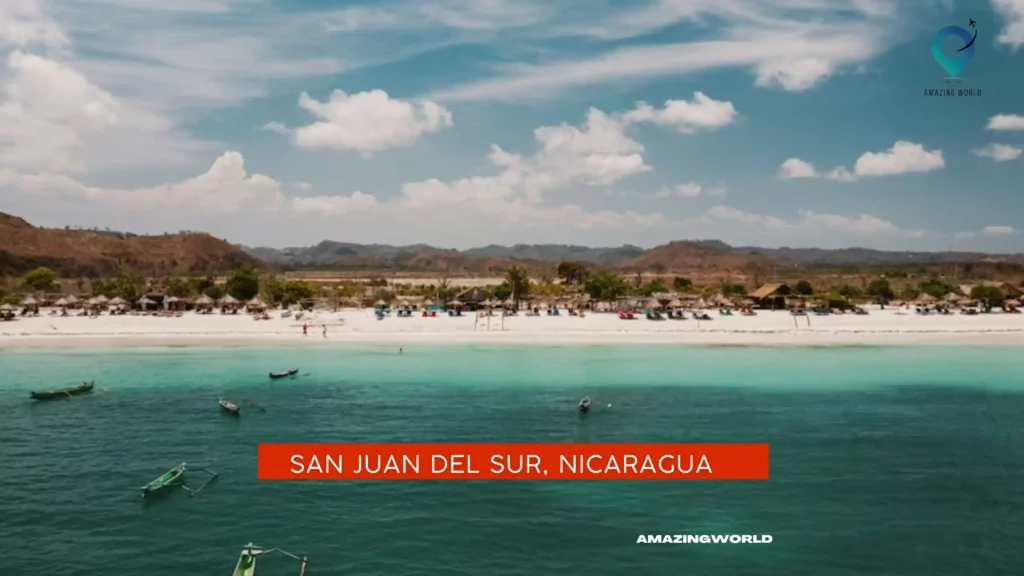
San Juan del Sur is a vibrant coastal town located on the Pacific coast of Nicaragua, known for its stunning beaches, excellent surfing, and lively beach parties.
Solo travelers looking for a fun and laid-back atmosphere should definitely consider adding San Juan del Sur to their itinerary.
Location: San Juan del Sur is located in the Rivas Department in southwest Nicaragua, about a 2–3-hour drive from the capital city of Managua.
Known for: San Juan del Sur is known for its beautiful beaches, world-class surfing, and lively nightlife.
The town is popular with backpackers and surfers, and visitors can enjoy a range of water sports and beach activities.
The Best Mode of Transportation: The best way to get around San Juan del Sur is on foot, as the town is small and easy to navigate.
Taxis and moto-taxis are also available for longer trips, and buses run to nearby towns and cities.
Daily Budget: The daily budget for a solo traveler in San Juan del Sur can range from $30-$100 USD per day, depending on your accommodation and dining preferences.
Hostels and budget-friendly hotels are available for around $10-$20 USD per night, while mid-range and luxury hotels can cost up to $200 USD per night.
Food and drinks are generally affordable, with meals starting at around $5 USD.
Culture: San Juan del Sur has a vibrant and diverse culture, with influences from indigenous communities, Spanish colonization, and modern-day tourism.
Visitors can learn about the local culture through music, dance, and festivals.
Nightlife: San Juan del Sur is famous for its lively nightlife, with beach parties and bars that stay open late into the night.
Visitors can enjoy live music, DJs, and drink specials at many of the town’s popular bars and clubs.
Food: San Juan del Sur has a range of dining options, from local street food to international cuisine. Seafood is a specialty in the area, with fresh fish and shellfish available at many restaurants.
Visitors can also try traditional Nicaraguan dishes like gallo pinto and vigorón.
Safety Measures: San Juan del Sur is generally a safe destination for solo travelers, but it’s important to take precautions like avoiding walking alone at night and keeping your valuables secure.
It’s also recommended to drink bottled water and to be aware of your surroundings during beach parties and nightlife activities.
Attractions: San Juan del Sur’s main attraction is its beautiful beaches, which offer excellent surfing, swimming, and sunbathing opportunities.
Other popular activities in the area include boat tours, horseback riding, and hiking in nearby nature reserves.
Some Travel Tips:
- Book accommodation in advance, especially during peak season (December to April)
- Bring plenty of sunscreens and insect repellent, as the sun and bugs can be intense
- Learn some basic Spanish phrases to communicate with locals
- Take a day trip to nearby Ometepe Island to see the twin volcanoes and learn about indigenous culture.
7. San Ignacio, Belize – Mayan Ruins & Jungle Adventures.
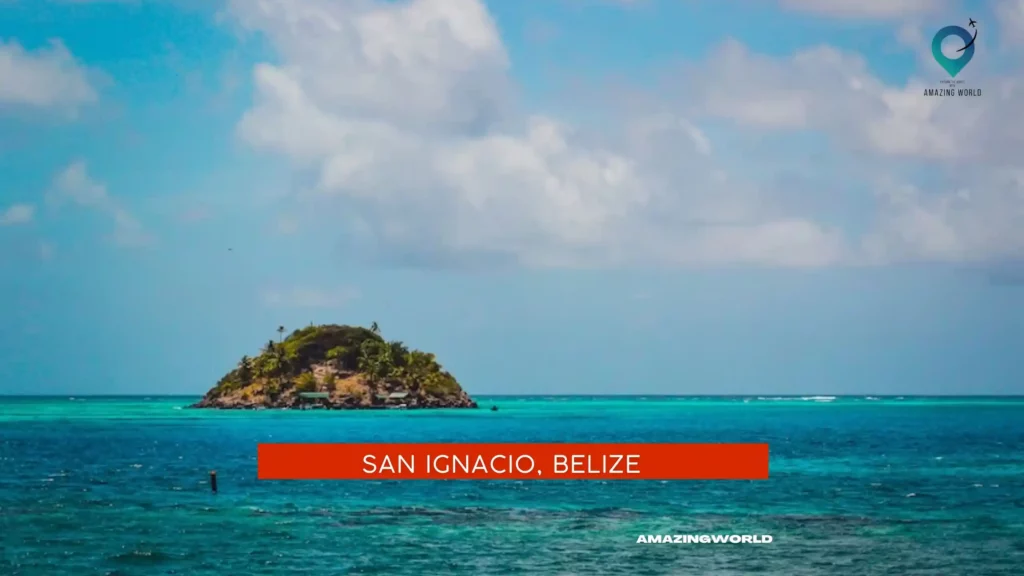
San Ignacio is a charming town located in western Belize, close to the Guatemalan border. It is known for its natural beauty and rich Mayan history, offering a unique experience for solo travelers seeking adventure and cultural immersion.
Location: San Ignacio is situated in the Cayo District of Belize, surrounded by lush jungles, rivers, and ancient ruins.
It is approximately 135 km west of Belize City and can be easily accessed by bus or car.
Known for: San Ignacio is renowned for its proximity to several Mayan ruins, including the famous Xunantunich and Cahal Pech archaeological sites.
Visitors can explore the remains of ancient cities and learn about Mayan history and culture. The town is also popular for its adventurous activities, such as caving, hiking, and zip-lining.
The best mode of transportation: The best way to get around San Ignacio is on foot, as most attractions are within walking distance.
However, visitors can also rent a bike or take a taxi to explore the surrounding areas.
Daily budget: Solo travelers can expect to spend around $50-$60 USD per day in San Ignacio, including accommodation, food, and transportation.
Culture: San Ignacio is a melting pot of various cultures, including Maya, Mestizo, and Garifuna.
Visitors can experience traditional dance performances, local cuisine, and immerse themselves in the daily life of the locals.
Nightlife: While San Ignacio is not known for its nightlife, there are a few bars and restaurants where visitors can socialize and enjoy a drink or two.
The town also hosts various cultural events throughout the year, such as the San Ignacio Town Fiesta.
Food: San Ignacio offers a range of cuisine, from traditional Mayan dishes to international fare. Visitors can try local specialties such as fry jacks, tamales, and rice and beans.
The town also has several vegetarian and vegan-friendly restaurants.
Safety measures: San Ignacio is generally considered safe for solo travelers, but it’s always important to take precautions.
Visitors should avoid walking alone at night, keep their valuables secure, and be aware of their surroundings.
Attractions: San Ignacio’s main attraction is its proximity to several Mayan ruins, including Xunantunich and Cahal Pech.
Visitors can also explore the nearby Mountain Pine Ridge Forest Reserve, where they can hike to waterfalls, swim in natural pools, and see ancient cave systems.
Some travel tips:
- Don’t forget to pack insect repellent and sunscreen, as the weather can be hot and humid.
- Consider hiring a local guide to learn more about the Mayan history and culture.
- Take a dip in the natural pools of the Rio on pools, located just outside of San Ignacio.
8. Copán, Honduras – Archaeological Site & Sculptures.
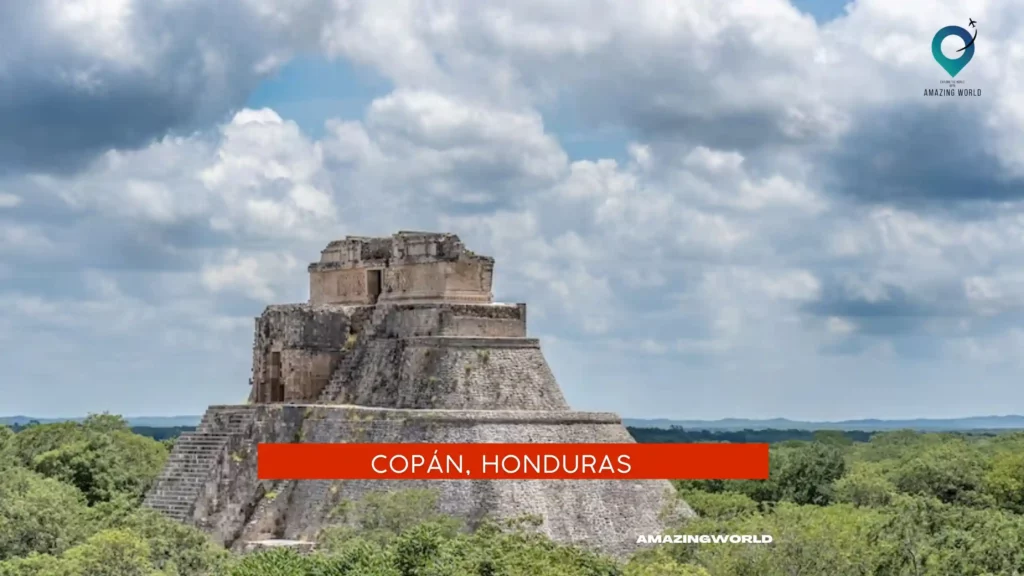
Located in western Honduras, Copán is a small town known for its archaeological site and ancient sculptures. The town is surrounded by lush greenery and is a peaceful retreat for those looking to explore ancient civilizations.
Location: Copán is located in the western part of Honduras, close to the Guatemalan border. The town is situated in a valley surrounded by hills, providing a scenic backdrop to the ancient ruins.
Known for: Copán is famous for its archaeological site, which dates back to the Mayan civilization. The site is home to intricately carved sculptures and hieroglyphics that offer a glimpse into the ancient Mayan culture.
The best mode of transportation: The best way to get around Copán is on foot, as the town is small and easily walkable. Taxis and buses are also available for those who need to travel outside of the town.
Daily Budget: The average daily budget for a solo traveler in Copán is around $30-40 USD, which includes accommodation, food, and transportation.
Culture: The town has a laid-back and friendly atmosphere, with a mix of Mayan and Spanish influences in its culture. Visitors can experience the local culture by visiting the colorful markets and interacting with the friendly locals.
Nightlife: Copán is not known for its nightlife, but there are a few bars and restaurants that offer a lively atmosphere in the evenings. The town is more suited for those looking for a peaceful retreat rather than a party scene.
Food: The local cuisine in Copán is a mix of Mayan and Spanish influences, with dishes such as tamales, pupusas, and baleadas.
Visitors can also find international cuisine in the town’s restaurants.
Safety measures: Copán is generally a safe destination, but visitors should take normal safety precautions such as avoiding walking alone at night and keeping valuables out of sight.
Attractions: The main attraction in Copán is the archaeological site, which includes the ruins of the ancient Mayan city and intricately carved sculptures.
Visitors can also take a horseback ride through the lush countryside or go bird watching in the nearby mountains.
Some travel tips:
- Wear comfortable shoes for exploring the archaeological site, as there is a lot of walking involved.
- Don’t miss the opportunity to try the local cuisine, as it offers a unique blend of flavors.
- Take a guided tour of the archaeological site to learn more about the history and culture of the Mayan civilization.
You Also May Like it– Top 22 Places to Visit in Phuket |Thailand
9. Caye Caulker, Belize – Island Vibes & Snorkeling.
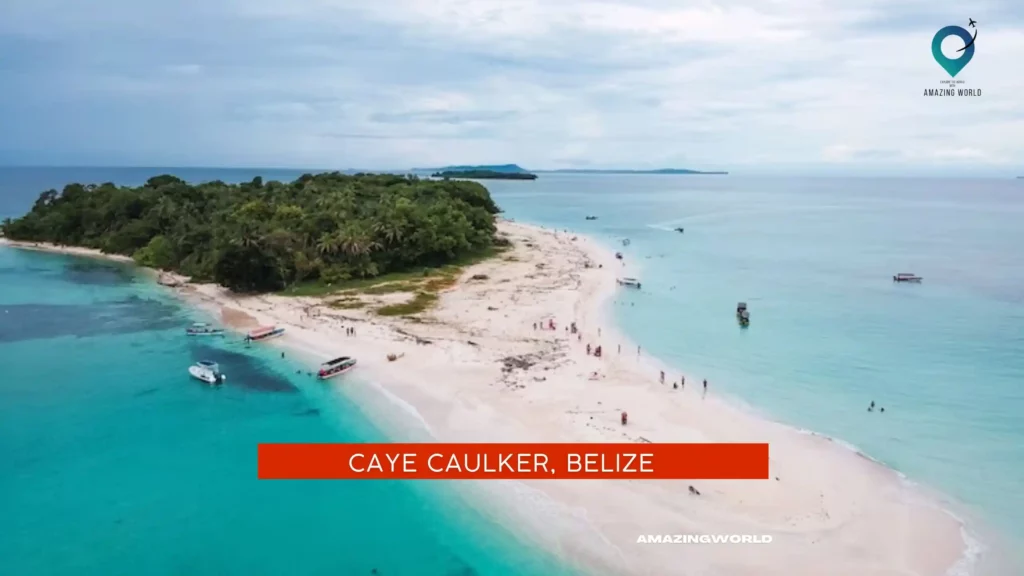
Caye Caulker, located off the coast of Belize, is a paradise for solo travelers seeking an island getaway. With its laid-back vibe, turquoise waters, and colorful houses, this small island has a unique charm that will captivate anyone who visits.
Location: Caye Caulker is a small island off the coast of Belize in the Caribbean Sea. It is situated about 20 miles north-northeast of Belize City and is accessible by water taxis or small planes.
Known for: Caye Caulker is known for its relaxed atmosphere, pristine beaches, and world-class snorkeling and diving.
It’s the perfect destination for those seeking an escape from the hustle and bustle of city life.
The best mode of transportation: The island is only about 5 miles long, and the best way to get around is by walking or renting a bike or golf cart.
There are no cars on the island, so you can enjoy a peaceful and serene atmosphere.
Daily budget: Caye Caulker is relatively affordable, with budget accommodation and food options available. You can expect to spend around $30-50 USD per day, depending on your activities and preferences.
Culture: The island has a mixed cultural heritage, with influences from the Garifuna, Maya, and Creole communities.
The locals are friendly and welcoming, and you can experience their unique way of life by participating in cultural activities such as drumming or dancing.
Nightlife: Caye Caulker has a vibrant nightlife, with bars and restaurants lining the beachfront. You can enjoy live music, dancing, and cocktails under the stars.
Food: The island offers a variety of local and international cuisine, with seafood being a specialty. You can try conch fritters, lobster, and fresh fish, or opt for vegan and vegetarian options.
Safety measures: Caye Caulker is generally a safe destination, but it’s always important to take precautions when traveling solo.
You should avoid walking alone at night and keep your valuables secure.
Attractions: Some of the top attractions in Caye Caulker include snorkeling at the Hol Chan Marine Reserve, swimming with nurse sharks at Shark Ray Alley, and enjoying the stunning sunsets from the Split.
You can also take a day trip to the neighboring island of Ambergris Caye.
Some travel tips: Be sure to bring plenty of sunscreen, bug spray, and comfortable shoes for walking on the sand.
It’s also a good idea to bring cash, as many places on the island do not accept credit cards. Finally, don’t forget to pack your snorkeling gear!
9. La Fortuna, Costa Rica – Arenal Volcano & Hot Springs.
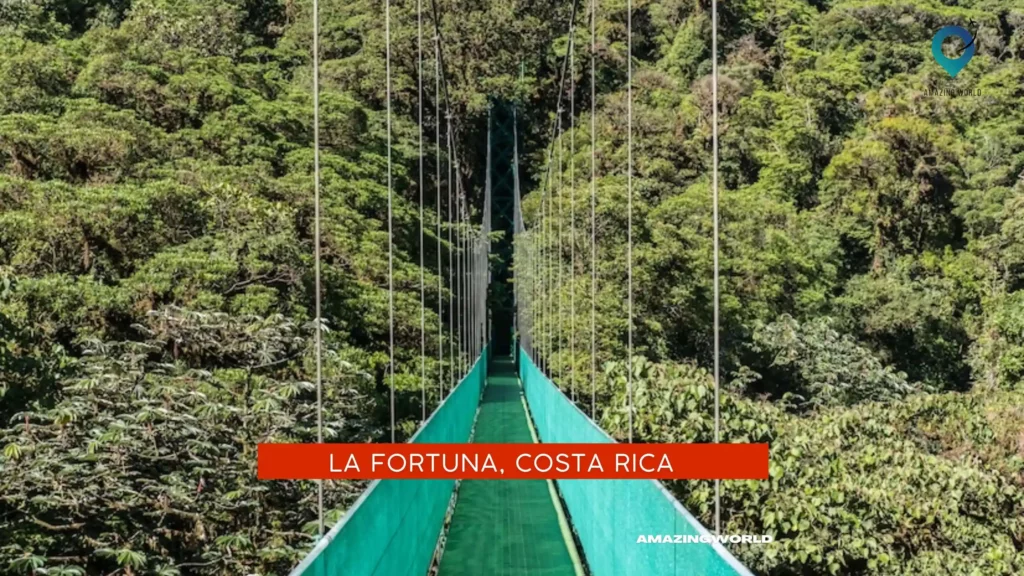
La Fortuna is a small town in Costa Rica, located in the northern part of the country. It is known for its stunning natural beauty, especially the Arenal Volcano, which is one of the most active volcanoes in the world.
The town is surrounded by lush rainforests, thermal hot springs, and breathtaking waterfalls. La Fortuna is a popular destination for adventure seekers, nature lovers, and those seeking relaxation in a tranquil setting.
Location: La Fortuna is situated in the province of Alajuela, in the northern part of Costa Rica. It is located about 3 hours away from the capital city, San Jose, and is easily accessible by bus, car, or shuttle.
Known for: La Fortuna is famous for the Arenal Volcano, which dominates the skyline and provides a spectacular backdrop for the town.
It is also known for its natural hot springs, which are said to have healing properties due to their high mineral content.
The town is surrounded by lush rainforests, and there are plenty of opportunities for outdoor activities such as hiking, zip-lining, and white-water rafting.
The Best Mode of Transportation: The best mode of transportation to get around La Fortuna is by foot or by car. Most attractions are within walking distance of the town center, and car rental is readily available.
Daily Budget: The average daily budget for La Fortuna is around $50-$100, depending on your accommodation and activity choices.
There are plenty of budget-friendly options for food and lodging, as well as more luxurious options for those seeking a more upscale experience.
Culture: La Fortuna is a small town with a laid-back atmosphere. The locals are friendly and welcoming, and there are plenty of opportunities to learn about Costa Rican culture and traditions.
Nightlife: La Fortuna is not known for its nightlife, but there are a few bars and restaurants in the town center where you can enjoy a drink and some live music.
Food: La Fortuna has a variety of dining options, from street food to upscale restaurants. The cuisine is predominantly Costa Rican, with a focus on fresh seafood and tropical fruits.
Safety Measures: La Fortuna is generally a safe destination for travelers, but it is always important to exercise caution and be aware of your surroundings.
It is recommended to use a safe or locker to store valuables and avoid walking alone at night.
Attractions: Some of the top attractions in La Fortuna include the Arenal Volcano National Park, the La Fortuna Waterfall, the Arenal Hot Springs, and the Sky Adventures zip-line park.
Some Travel Tips:
- Bring comfortable shoes and clothes for outdoor activities.
- Don’t forget to pack insect repellent and sunscreen.
- Try the local cuisine, including fresh seafood and tropical fruits.
- Take a dip in the natural hot springs for a relaxing and rejuvenating experience.
10. Leon, Nicaragua – Colonial Architecture & Revolutionary History.
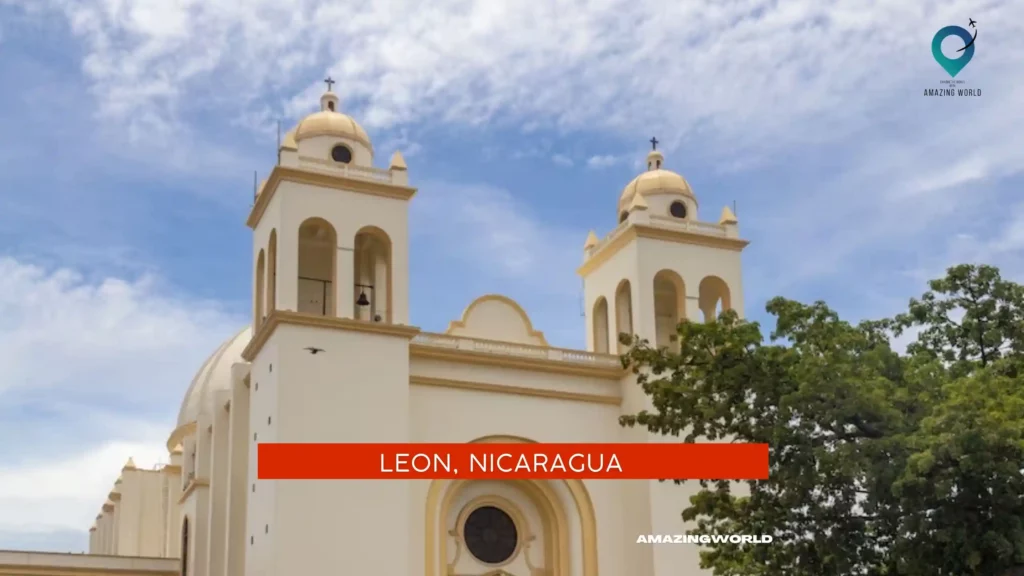
Leon is a city located in western Nicaragua, known for its rich colonial architecture and revolutionary history. This city offers a blend of fascinating historical landmarks, stunning natural attractions, and a vibrant arts and culture scene, making it a perfect destination for solo travelers seeking adventure and exploration.
Location: Leon is located about 90 kilometers northwest of Managua, the capital city of Nicaragua. It is situated near the Pacific Ocean and is surrounded by several volcanic peaks.
Known for: Leon is known for its beautifully preserved colonial architecture, revolutionary history, and cultural diversity. The city is also famous for its lively music scene, street art, and delicious street food.
The best mode of transportation: The best mode of transportation in Leon is walking or cycling. The city is relatively small, and most of its attractions can be easily reached on foot or by bike. Taxis and buses are also available for longer distances.
Daily Budget: The daily budget for travelers in Leon can range from $30 to $50 per day, depending on the level of comfort and activities undertaken.
Culture: Leon is known for its rich cultural heritage, which can be experienced through its music, art, and cuisine. The city has a diverse population, with influences from Spanish, African, and indigenous cultures.
Nightlife: Leon offers a vibrant nightlife scene, with numerous bars and clubs that cater to both locals and tourists. The city is known for its live music and salsa dancing.
Food: Leon is a food lover’s paradise, with a variety of delicious street food and traditional dishes. Some popular local dishes include gallo pinto, vigorón, and quesillo.
Safety measures: Travelers should take usual safety precautions while visiting Leon, including avoiding isolated areas at night and keeping valuables secure.
Attractions: Some of the top attractions in Leon include the Cathedral of Leon, the Museum of the Revolution, and the Rubén Darío Museum.
The nearby Maribios volcanic chain and beaches of Las Peñitas are also popular day trips.
Some travel tips: When visiting Leon, it’s recommended to wear comfortable walking shoes and carry plenty of water to stay hydrated. It’s also a good idea to learn some basic Spanish, as most locals speak little to no English.
11. Bocas del Toro, Panama – Caribbean Archipelago & Beaches.
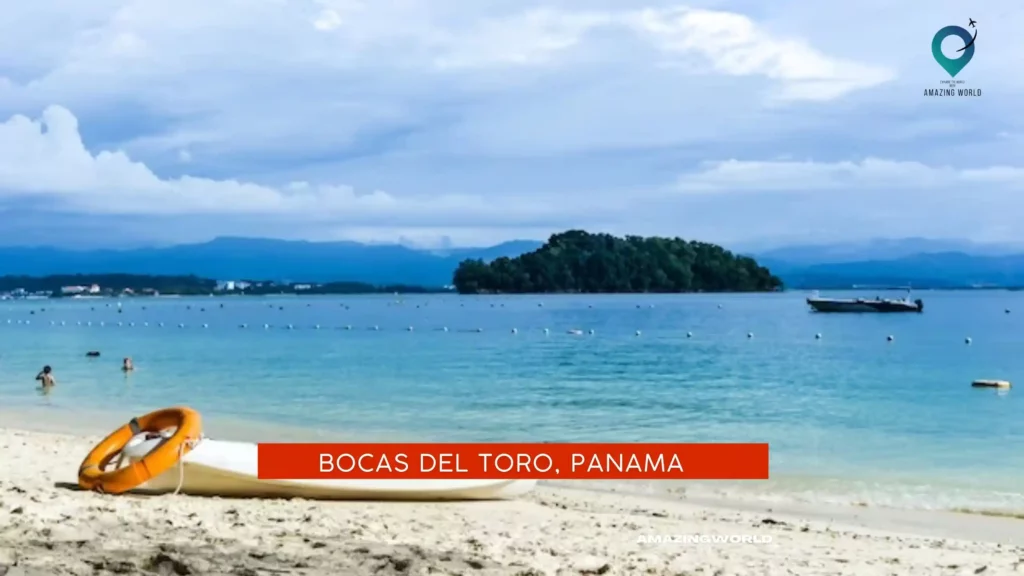
Bocas del Toro, a hidden gem in Panama, is a tropical paradise that offers everything you could want in a Caribbean vacation. From picturesque beaches to vibrant coral reefs, this archipelago has something for everyone.
Bocas del Toro is an ideal destination for solo travelers seeking adventure, relaxation, and a unique cultural experience.
Location: Bocas del Toro is an archipelago located in the northwestern part of Panama. The main island, Isla Colon, is the largest and most developed of the islands.
Known for: Bocas del Toro is known for its stunning natural beauty and rich cultural heritage. It’s a perfect destination for travelers who want to explore the outdoors, relax on the beach, and immerse themselves in the local culture.
The best mode of transportation: The best way to get around the islands is by boat or water taxi. There are several options available for island hopping and exploring the various beaches and attractions.
Daily Budget: Bocas del Toro can be relatively expensive compared to other destinations in Central America. However, travelers can still find affordable accommodation and dining options if they plan accordingly.
The average daily budget can range from $50 to $100 USD, depending on your travel style and preferences.
Culture: The culture of Bocas del Toro is a unique blend of Afro-Caribbean, Indigenous, and Spanish influences.
You can see this influence in the music, dance, and cuisine of the region. The locals are warm and welcoming, and visitors can easily immerse themselves in the local culture.
Nightlife: Bocas del Toro has a vibrant nightlife scene with many bars and clubs that cater to travelers and locals.
The nightlife is a mix of Caribbean and Latin music, and visitors can enjoy dancing, socializing, and trying local drinks.
Food: The food in Bocas del Toro is a fusion of Caribbean, Latin, and Indigenous cuisine. Visitors can enjoy fresh seafood, plantains, and other local specialties.
There are also many international restaurants and cafes that cater to different tastes.
Safety measures: Bocas del Toro is generally a safe destination for travelers. However, visitors should still take standard precautions such as avoiding walking alone at night and being aware of their surroundings.
Attractions: Some of the top attractions in Bocas del Toro include exploring the beaches, snorkeling, diving, and surfing.
Other popular activities include hiking, visiting local indigenous communities, and exploring the nightlife.
Some travel tips: Some essential travel tips for Bocas del Toro include bringing sunscreen, insect repellent, and cash, as credit cards are not accepted everywhere.
Visitors should also be prepared for occasional rain showers and pack accordingly. It’s also a good idea to learn some basic Spanish phrases as the locals primarily speak Spanish.
12. San Salvador, El Salvador – City Culture & Volcanoes.
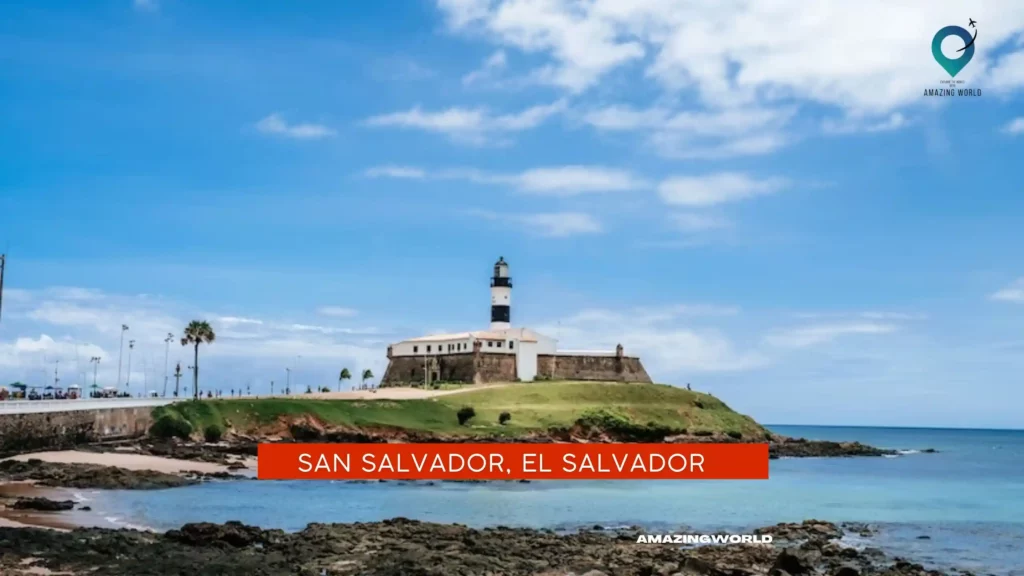
San Salvador, the capital city of El Salvador, is a vibrant and bustling metropolis that offers a mix of city culture and natural beauty. The city has undergone significant transformations in recent years, with the restoration of historical landmarks and the development of modern infrastructure.
It is a great destination for solo travelers looking to explore Central America’s urban landscapes and immerse themselves in the local culture.
Location: San Salvador is located in the central region of El Salvador, in the heart of Central America. It is surrounded by beautiful landscapes, including the San Salvador volcano and the Boqueron National Park.
Known for: San Salvador is known for its rich history, colonial architecture, museums, and art galleries. It is also a hub for music, dance, and street art. The city has a thriving street food scene and is famous for its pupusas, a traditional Salvadoran dish.
The best mode of transportation: The best way to get around San Salvador is by using the public transport system, which includes buses, microbuses, and taxis. However, if you plan to explore the city’s surroundings, renting a car or taking a guided tour is recommended.
Daily Budget: San Salvador is a budget-friendly destination, with accommodation and food options to suit all budgets. A daily budget of $30-$50 should be enough for a solo traveler, including accommodation, food, and transportation.
Culture: The culture of San Salvador is a mix of indigenous, European, and African influences, reflected in the city’s music, dance, and cuisine.
The city has a rich history of Mayan and Aztec civilizations, as well as Spanish colonization and modern-day struggles for independence.
Nightlife: San Salvador has a vibrant nightlife scene, with a variety of bars, clubs, and music venues. The Zona Rosa district is a popular spot for nightlife, with a range of options to suit different tastes and budgets.
Food: San Salvador is known for its street food scene and traditional dishes, including pupusas, tamales, and ceviche.
The Mercado Central is a great place to sample local cuisine and experience the bustling atmosphere of a typical Salvadoran market.
Safety measures: As with any major city, it’s important to take safety precautions when visiting San Salvador.
It’s recommended to avoid traveling alone at night and to be aware of your surroundings at all times.
It’s also advisable to keep your valuables secure and avoid displaying expensive items in public.
Attractions: San Salvador has several attractions worth exploring, including the National Palace, the Museum of Anthropology, and the El Boqueron National Park.
Other notable landmarks include the Metropolitan Cathedral and the San Salvador volcano.
Some travel tips:
- Learn some basic Spanish phrases to help you communicate with locals.
- Wear comfortable shoes, as there is a lot of walking involved in exploring the city.
- Be respectful of the local customs and traditions, including dress codes and religious practices.
- Always carry a copy of your passport and important travel documents with you.
13. Ometepe Island, Nicaragua – Twin Volcano Island & Hiking.

Ometepe Island in Nicaragua is a natural gem that draws in solo travelers with its unique twin volcanic peaks, lush forests, and tranquil beaches.
It’s an ideal destination for adventure seekers and nature lovers who want to explore off-the-beaten-path destinations.
Location: Ometepe Island is located in Lake Nicaragua, which is the largest lake in Central America. It is accessible by a ferry ride from the mainland, which takes about 1-2 hours.
Known for: Ometepe Island is known for its two majestic volcanoes, Concepcion and Maderas, which are popular for hiking and offer breathtaking views of the surrounding landscapes.
The island is also home to many archaeological sites, pristine beaches, and wildlife reserves.
The best mode of transportation: The best mode of transportation on the island is a bike or scooter, which can be rented from various places. Taxis and buses are also available for getting around the island.
Daily Budget: Ometepe Island is relatively affordable, and the daily budget for a solo traveler can range from $30-$50, depending on the type of accommodation and activities chosen.
Culture: Ometepe Island has a rich cultural heritage that is evident in the various archaeological sites and museums located on the island.
The island is also home to many indigenous communities that have preserved their traditions and way of life.
Nightlife: The nightlife on the island is relatively low-key, with a few bars and restaurants that offer live music and entertainment. However, the island’s natural beauty and tranquility make it an ideal place for relaxation.
Food: Ometepe Island offers a range of local and international cuisine, including fresh seafood, traditional Nicaraguan dishes, and vegetarian options. Many restaurants on the island use organic and locally sourced ingredients.
Safety measures: Ometepe Island is generally safe, but travelers should be cautious of petty crime and take necessary precautions, such as avoiding secluded areas at night and keeping valuables safe.
Attractions: The main attractions on Ometepe Island are the two volcanoes, Concepcion and Maderas, which offer excellent hiking opportunities and stunning views.
Other attractions include the Ojo de Agua natural spring, San Ramon waterfall, and the Charco Verde Nature Reserve.
Some travel tips:
- Be sure to bring sturdy hiking shoes and comfortable clothing for exploring the island’s natural wonders.
- Rent a bike or scooter to get around the island, but be cautious of the unpaved roads and hills.
- Visit during the dry season (November to April) for optimal hiking conditions and clear views.
- Take a break from technology and enjoy the island’s natural beauty and tranquility.
14. Tulum, Mexico – Mayan Ruins & Beaches.
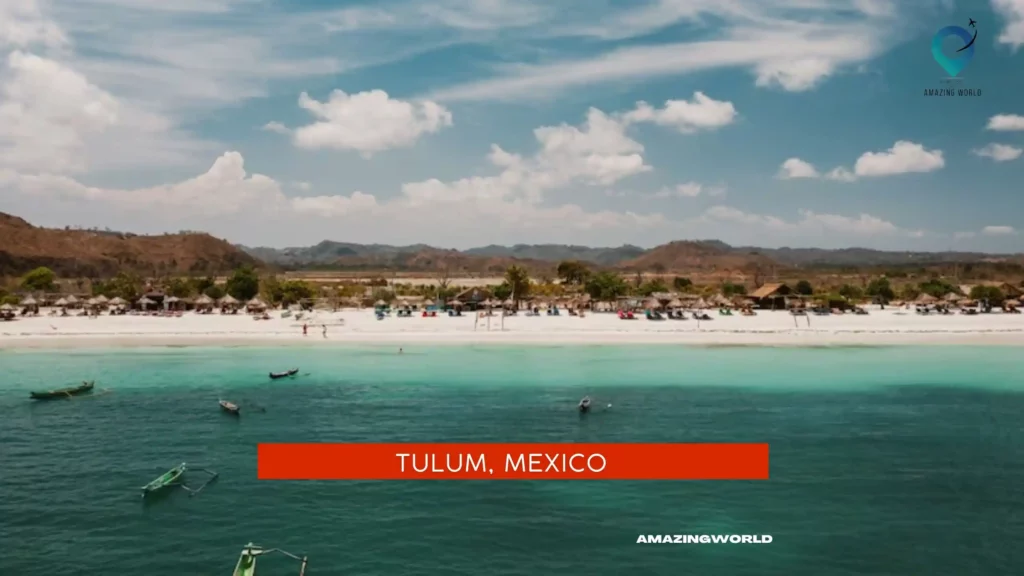
Tulum, located on the east coast of the Yucatan Peninsula, is a charming Mexican town that has become a popular destination for travelers seeking a mix of history, culture, and natural beauty.
Known for its stunning white-sand beaches, turquoise waters, and well-preserved Mayan ruins, Tulum offers a perfect blend of relaxation and adventure.
Location: Tulum is situated approximately 130 km (80 miles) south of Cancun, and 65 km (40 miles) south of Playa del Carmen.
The town is nestled between the Caribbean Sea to the east and the lush jungle to the west, creating a unique and picturesque landscape.
Known for: Tulum is known for its impressive Mayan ruins, which are located on a cliff overlooking the Caribbean Sea. The ruins date back to the 13th century and were once a thriving Mayan port city.
Tulum is also known for its beautiful beaches, including Playa Paraiso, which is consistently ranked as one of the best beaches in the world.
The best mode of transportation: The most convenient mode of transportation in Tulum is by bike or scooter.
Tulum is a small town, and many of the attractions are within biking distance of each other. Bikes and scooters can be rented easily and affordably in town.
Daily Budget: The daily budget for Tulum depends on your travel style and preferences. On average, a budget traveler can expect to spend around $50-60 per day, while mid-range travelers can expect to spend around $100-150 per day. Luxury travelers can expect to spend upwards of $300 per day.
Culture: Tulum is a hub of Mexican culture and history. The town is home to many galleries, museums, and art exhibitions, showcasing the works of local and international artists.
Visitors can also experience traditional Mexican cuisine, music, and dance at the many restaurants and bars in town.
Nightlife: Tulum’s nightlife scene is relatively laid-back and centered around beachfront bars and clubs. Most bars close by midnight, but a few stay open late into the night.
The town also hosts a variety of live music performances and cultural events throughout the year.
Food: Tulum’s food scene is a mix of traditional Mexican cuisine and international fusion dishes.
The town is famous for its fresh seafood, and many restaurants offer oceanfront dining experiences. Vegan and vegetarian options are also widely available.
Safety measures: Tulum is generally a safe destination for travelers. However, it is important to take standard safety precautions, such as not walking alone at night and not leaving valuables unattended.
Attractions: In addition to the Mayan ruins and beaches, Tulum offers a variety of attractions for travelers, including Cenote Dos Ojos, a natural swimming hole with crystal-clear waters, and Sian Ka’an Biosphere Reserve, a protected area of tropical forest, mangroves, and wetlands.
Some travel tips:
- Visit the Mayan ruins early in the morning to avoid crowds and heat.
- Bring plenty of sunscreen and mosquito repellent.
- Book your accommodations and tours in advance, especially during high season.
- Explore the nearby cenotes for a unique and refreshing swimming experience.
15. Tortuguero, Costa Rica – Sea Turtles & Jungle Canals.

Tulum, located on the east coast of the Yucatan Peninsula, is a charming Mexican town that has become a popular destination for travelers seeking a mix of history, culture, and natural beauty.
Known for its stunning white-sand beaches, turquoise waters, and well-preserved Mayan ruins, Tulum offers a perfect blend of relaxation and adventure.
Location: Tulum is situated approximately 130 km (80 miles) south of Cancun, and 65 km (40 miles) south of Playa del Carmen.
The town is nestled between the Caribbean Sea to the east and the lush jungle to the west, creating a unique and picturesque landscape.
Known for: Tulum is known for its impressive Mayan ruins, which are located on a cliff overlooking the Caribbean Sea. The ruins date back to the 13th century and were once a thriving Mayan port city.
Tulum is also known for its beautiful beaches, including Playa Paraiso, which is consistently ranked as one of the best beaches in the world.
The best mode of transportation: The most convenient mode of transportation in Tulum is by bike or scooter.
Tulum is a small town, and many of the attractions are within biking distance of each other. Bikes and scooters can be rented easily and affordably in town.
Daily Budget: The daily budget for Tulum depends on your travel style and preferences. On average, a budget traveler can expect to spend around $50-60 per day, while mid-range travelers can expect to spend around $100-150 per day.
Luxury travelers can expect to spend upwards of $300 per day.
Culture: Tulum is a hub of Mexican culture and history. The town is home to many galleries, museums, and art exhibitions, showcasing the works of local and international artists.
Visitors can also experience traditional Mexican cuisine, music, and dance at the many restaurants and bars in town.
Nightlife: Tulum’s nightlife scene is relatively laid-back and centered around beachfront bars and clubs. Most bars close by midnight, but a few stay open late into the night.
The town also hosts a variety of live music performances and cultural events throughout the year.
Food: Tulum’s food scene is a mix of traditional Mexican cuisine and international fusion dishes.
The town is famous for its fresh seafood, and many restaurants offer oceanfront dining experiences. Vegan and vegetarian options are also widely available.
Safety measures: Tulum is generally a safe destination for travelers. However, it is important to take standard safety precautions, such as not walking alone at night and not leaving valuables unattended.
Attractions: In addition to the Mayan ruins and beaches, Tulum offers a variety of attractions for travelers, including Cenote Dos Ojos, a natural swimming hole with crystal-clear waters, and Sian Ka’an Biosphere Reserve, a protected area of tropical forest, mangroves, and wetlands.
Some travel tips:
- Visit the Mayan ruins early in the morning to avoid crowds and heat.
- Bring plenty of sunscreens and mosquito repellent.
- Book your accommodations and tours in advance, especially during high season.
- Explore the nearby cenotes for a unique and refreshing swimming experience.
16. La Ceiba, Honduras – Adventure Hub & Beaches.

Located on the Caribbean coast of Honduras, La Ceiba is a vibrant city that serves as a gateway to some of the country’s most thrilling outdoor adventures. From hiking and rafting to diving and beach hopping, La Ceiba is a hub for adrenaline seekers looking to explore the natural beauty of Honduras.
Location: La Ceiba is located on the northern coast of Honduras, about 180 kilometers (110 miles) northeast of the capital city of Tegucigalpa.
Known for: La Ceiba is known for its lively atmosphere, stunning beaches, and access to some of the best adventure activities in Honduras. It’s also home to the country’s largest carnival celebration, which takes place every May.
The best mode of transportation: The easiest way to get around La Ceiba is by taxi or bus. Buses are the most affordable option, but taxis offer more flexibility and comfort.
Daily Budget: A daily budget of $30-$50 USD should be sufficient for budget travelers. Mid-range travelers should expect to spend $60-$100 USD per day, while luxury travelers can expect to spend upwards of $150 USD per day.
Culture: La Ceiba has a vibrant cultural scene, with a mix of Afro-Caribbean, Garifuna, and indigenous Honduran influences. The city is home to a number of museums, galleries, and cultural events, such as the May carnival celebration.
Nightlife: La Ceiba has a lively nightlife scene, with a variety of bars, clubs, and live music venues to choose from. The area around Avenida San Isidro is particularly popular for nightlife.
Food: La Ceiba is known for its seafood, which can be found in abundance at the local restaurants and street vendors. Other popular dishes include baleadas (a type of tortilla filled with beans, cheese, and other toppings), and pastelitos (fried meat pies).
Safety measures: While La Ceiba is generally a safe city, it’s important to take precautions such as avoiding walking alone at night and keeping an eye on your belongings. It’s also a good idea to research the safety of the specific areas you plan to visit.
Attractions: Some of the top attractions in La Ceiba include Pico Bonito National Park, Cayos Cochinos Marine Reserve, and the Cangrejal River. The city also has several beautiful beaches, such as Playa de los Tintos and Playa de la Mocuana.
Some travel tips:
- Bring insect repellent, as mosquitoes and other bugs can be a nuisance in the area.
- If you plan to hike or raft, make sure to bring appropriate gear such as sturdy shoes and a waterproof jacket.
- Learn a few basic phrases in Spanish, as English is not widely spoken in La Ceiba.
17. Flores, Guatemala – Tikal Ruins & Lake Views.
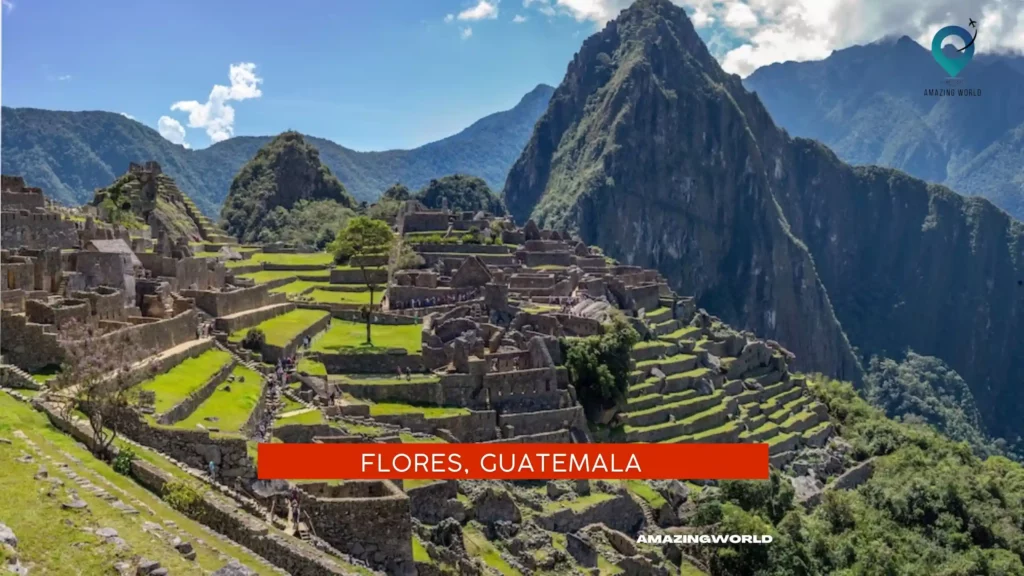
Located in the heart of Guatemala, Flores is a small and charming island town that serves as a gateway to the world-renowned Tikal ruins.
With its picturesque cobblestone streets, colorful buildings, and stunning views of Lake Petén Itzá, Flores is a must-visit destination for any traveler exploring Central America.
Location: Flores is located in the northern region of Guatemala, in the department of Petén.
It is situated on an island in Lake Petén Itzá, which is surrounded by dense jungle and is a short drive away from the Tikal ruins.
Known for: Flores is known for its colonial charm, stunning lake views, and proximity to the Tikal ruins, one of the most important archaeological sites in the world.
It is also a popular destination for outdoor enthusiasts, with opportunities for hiking, kayaking, and wildlife spotting in the surrounding jungle.
The best mode of transportation: The best way to get to Flores is by flying into Mundo Maya International Airport in the nearby city of Santa Elena.
Once in Flores, the best mode of transportation is on foot or by tuk-tuk, as cars are not allowed on the island.
Daily Budget: A daily budget of around $50-70 USD should be sufficient for a comfortable stay in Flores, including accommodations, food, and activities.
Culture: Flores is rich in both Mayan and colonial Spanish history and culture, with many ancient ruins and colonial buildings to explore.
The locals are friendly and welcoming, and visitors can experience traditional Mayan cuisine and customs.
Nightlife: While Flores is not known for its nightlife, there are a few bars and restaurants that offer live music and a laid-back atmosphere for a night out.
Food: Visitors to Flores can enjoy a variety of local and international cuisine, with a focus on traditional Mayan dishes such as tamales and chiles rellenos.
Fresh seafood is also readily available due to the town’s location on the lake.
Safety measures: While Flores is generally a safe destination, travelers should take precautions against pickpocketing and theft.
It is also recommended to use a licensed tour guide when visiting the Tikal ruins to ensure safety and respect for the site’s cultural and environmental significance.
Attractions: The main attraction in Flores is the Tikal ruins, which are a UNESCO World Heritage Site and the largest excavated Mayan ruins in Central America.
Visitors can also explore the island’s charming colonial architecture, take a boat tour of the lake, or hike in the surrounding jungle.
Some travel tips:
- Be sure to bring bug spray and sunscreen, as the region can be hot and humid with mosquitoes.
- Use a licensed tour guide when visiting Tikal to learn more about the site’s history and cultural significance.
- Consider taking a day trip to nearby Yaxhá ruins or El Remate for more Mayan ruins and jungle adventures.
18. Puerto Viejo, Costa Rica – Afro-Caribbean Culture & Beaches.
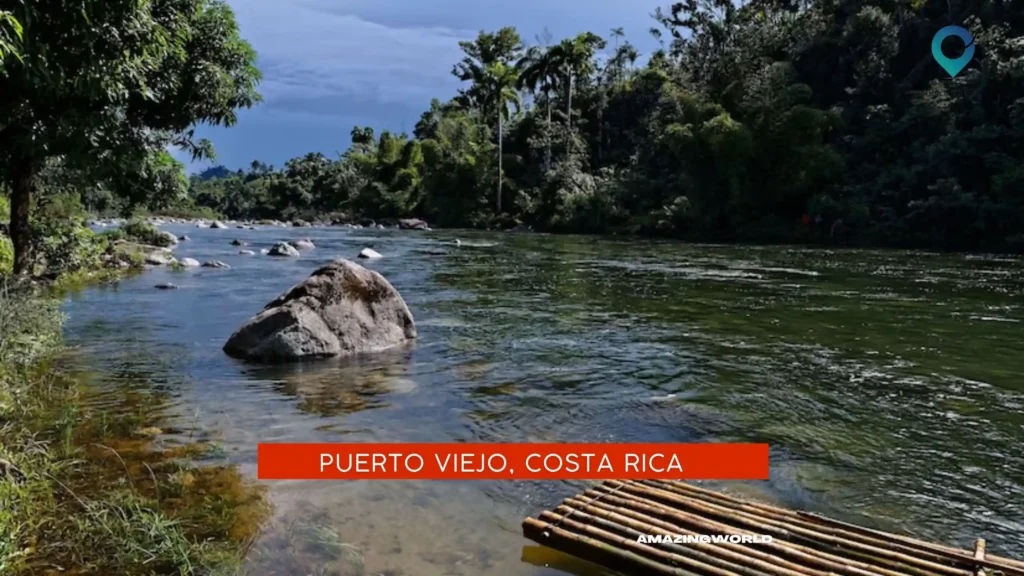
Puerto Viejo is a small town located on the southern Caribbean coast of Costa Rica. This laid-back town is known for its Afro-Caribbean culture, beautiful beaches, and abundant wildlife.
It’s a popular destination for solo travelers looking to relax, immerse themselves in a unique culture, and explore the natural beauty of Costa Rica.
Location: Puerto Viejo is located on the southern Caribbean coast of Costa Rica, in the province of Limon.
Known for: Puerto Viejo is known for its Afro-Caribbean culture, which is evident in the local cuisine, music, and traditions.
The town is also famous for its beautiful beaches, which are perfect for surfing, swimming, and sunbathing. The area is home to several wildlife reserves, where visitors can see sloths, monkeys, and exotic birds.
The best mode of transportation: The best way to get around Puerto Viejo is on foot or by bike. The town is small enough to walk around, and there are several bike rental shops in town.
Daily budget: The daily budget for Puerto Viejo can vary depending on your accommodation and food choices.
However, on average, a budget of $50-70 per day should be enough to cover accommodation, food, and activities.
Culture: The Afro-Caribbean culture in Puerto Viejo is a blend of African, European, and indigenous influences.
The locals are friendly and welcoming, and visitors can experience the culture through the food, music, and festivals.
Nightlife: Puerto Viejo has a vibrant nightlife scene, with several bars and clubs that stay open late into the night.
The nightlife is centered around reggae music, and visitors can enjoy live music performances and dance the night away.
Food: The food in Puerto Viejo is a fusion of Afro-Caribbean and Costa Rican cuisine. Visitors can try traditional dishes like rice and beans, plantains, and jerk chicken.
There are also plenty of seafood options, including fresh fish and shrimp.
Safety measures: Puerto Viejo is generally a safe place to visit, but it’s always important to take precautions.
Visitors should avoid walking alone at night, keep their valuables safe, and be aware of their surroundings.
Attractions: The main attractions in Puerto Viejo are the beautiful beaches and wildlife reserves.
Visitors can also take a cultural tour of the town, visit the local markets, and take part in water sports like surfing and snorkeling.
Some travel tips:
- Don’t forget to pack insect repellent as mosquitoes and other bugs are common in the area.
- The best time to visit Puerto Viejo is between December and April when the weather is dry and sunny.
- If you’re planning to rent a bike, make sure to wear a helmet and follow the local traffic rules.
- Always check the surf conditions before heading out to the beach to ensure your safety.
19. San Pedro, Belize – Scuba Diving & Island Life.
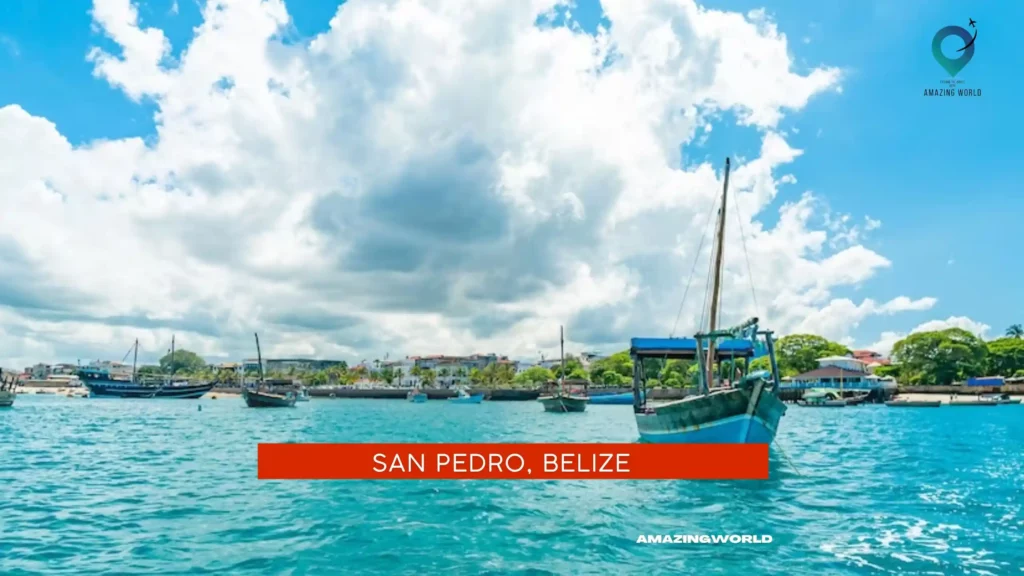
San Pedro is a charming little town situated on the southern part of Ambergris Caye, the largest island in Belize. It is a popular destination for solo travelers seeking an escape to paradise.
With crystal-clear waters, abundant marine life, and a laid-back Caribbean atmosphere, San Pedro offers a perfect mix of adventure and relaxation.
Location: San Pedro is located on Ambergris Caye, which is situated off the northeastern coast of Belize in the Caribbean Sea.
Known for: San Pedro is known for its incredible scuba diving and snorkeling opportunities. The town has a relaxed vibe with stunning beaches, friendly locals, and an abundance of seafood.
The Best Mode of Transportation: The best mode of transportation in San Pedro is by golf cart, bicycle, or on foot, as cars are not allowed on the island.
Daily Budget: The daily budget in San Pedro ranges from $50 to $100, depending on the type of accommodation and activities you choose.
Culture: San Pedro has a unique blend of cultures, including Mayan, Spanish, and Afro-Caribbean. The locals are friendly and welcoming, and the town has a laid-back atmosphere.
Nightlife: San Pedro has a vibrant nightlife scene with numerous beach bars, nightclubs, and restaurants.
Food: The food in San Pedro is a mix of traditional Belizean cuisine and Caribbean flavors, with seafood being a staple.
Safety Measures: San Pedro is generally a safe destination for solo travelers, but it is always important to be aware of your surroundings and take necessary safety precautions.
Attractions: Some of the top attractions in San Pedro include scuba diving, snorkeling, fishing, exploring the town’s colorful street art, and visiting the nearby Hol Chan Marine Reserve.
Some Travel Tips: It is recommended to book your accommodation and activities in advance, especially during peak travel season.
Also, make sure to pack sunscreen, mosquito repellent, and comfortable walking shoes.
20. Utila, Honduras – Dive Certification & Beaches.

Utila is a small Caribbean Island off the coast of Honduras, known for its stunning beaches and exceptional scuba diving opportunities.
With its laid-back vibe and affordable prices, Utila has become a popular destination for travelers seeking a tropical escape.
Location: Utila is located in the Bay Islands of Honduras, about 18 miles from the mainland. It is the smallest of the three major islands, with a total area of just 11 square miles.
Known for: Utila is best known for its scuba diving, with numerous dive shops offering courses and trips to explore the island’s stunning coral reefs.
The island also boasts beautiful beaches, clear blue waters, and a relaxed atmosphere.
The best mode of transportation: As a small island, walking or biking is the easiest way to get around Utila. You can also rent a scooter or take a tuk-tuk to explore the island.
Daily Budget: Utila is a budget-friendly destination, with affordable accommodations and dining options. A daily budget of $30-50 USD is reasonable for a solo traveler.
Culture: The culture of Utila is influenced by its Afro-Caribbean heritage, with a mix of English, Spanish, and Creole spoken on the island.
The locals are friendly and welcoming, and there is a laid-back vibe that reflects the island’s relaxed lifestyle.
Nightlife: The nightlife in Utila is lively, with a variety of bars and restaurants to choose from.
The island is particularly popular with backpackers, and there are plenty of opportunities to meet fellow travelers and socialize.
Food: Utila offers a range of dining options, from street food vendors to upscale restaurants. Seafood is a particular specialty, with fresh catches of the day served up in many eateries.
Be sure to try the island’s signature dish, baleadas, which are tortillas filled with beans, cheese, and other toppings.
Safety measures: Utila is generally a safe destination, but it is still important to take precautions such as avoiding walking alone at night and keeping your valuables secure.
It is also recommended to use a reputable dive shop for scuba diving activities.
Attractions: Aside from scuba diving and relaxing on the beach, Utila also offers other attractions such as kayaking, snorkeling, and hiking.
You can also visit the island’s small museum to learn more about its history and culture.
Some travel tips:
- Utila is known for its affordable scuba diving courses, so it’s a great place to get certified.
- Be sure to pack mosquito repellent and sunscreen, as the island can be quite hot and humid.
- If you’re traveling during peak season (December-January), be sure to book your accommodations and activities in advance, as the island can get busy.
21. Masaya, Nicaragua – Artisan Market & Volcanic Lake.
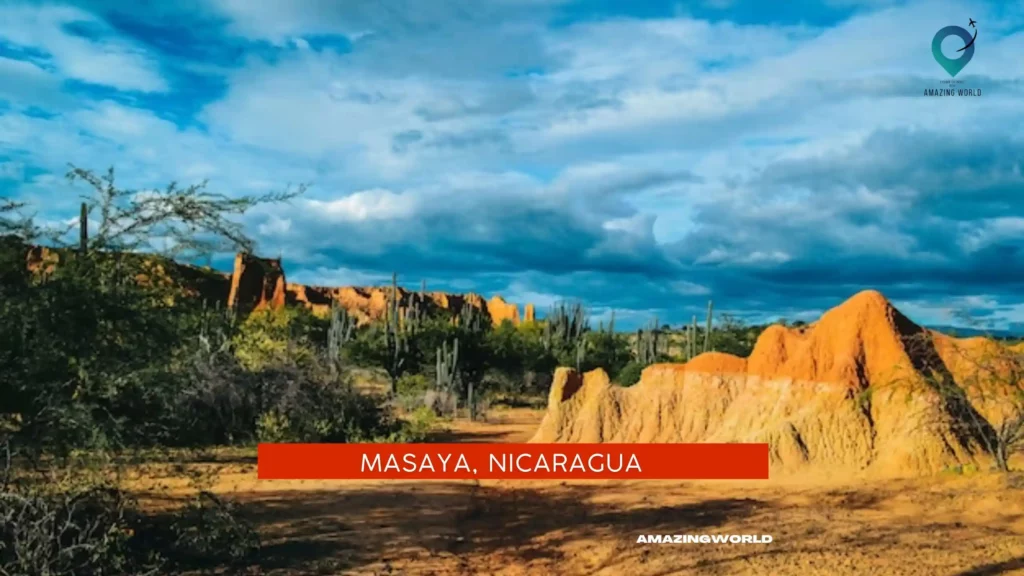
Masaya, a city in Nicaragua, is a hidden gem for travelers who want to explore the country’s cultural heritage and natural beauty. Known for its vibrant artisan market and stunning volcanic lake, Masaya offers a unique blend of history, tradition, and adventure.
Location:
Masaya is located in the western part of Nicaragua, about 14 miles southeast of the capital city of Managua. The city is situated at the foot of the Masaya Volcano National Park, which is home to two active volcanoes.
Known for:
Masaya is renowned for its colorful and bustling artisan market, where visitors can find a wide variety of handcrafted goods such as pottery, textiles, and souvenirs. The city is also known for the Masaya Volcano National Park, which offers stunning views of the smoking crater and a picturesque volcanic lake.
The best mode of transportation:
The best way to explore Masaya is on foot, as many of the city’s attractions are located within walking distance of each other. Taxis are also available for those who want to travel further afield, and local buses connect Masaya to other cities and towns in Nicaragua.
Daily Budget:
Masaya is an affordable destination for travelers, with a daily budget of around $30-40 USD for basic accommodations, food, and transportation. Prices may vary depending on the season and level of comfort desired.
Culture:
Masaya has a rich cultural heritage that is deeply rooted in indigenous traditions and Spanish colonial history. Visitors can experience local culture by attending traditional festivals and events, such as the Feast of San Jeronimo or the Day of the Dead celebrations.
Nightlife:
While Masaya is not known for its nightlife, there are a few bars and restaurants where visitors can enjoy a drink or meal in the evening. Some local establishments offer live music or cultural performances on weekends.
Food:
Masaya’s cuisine is a reflection of the region’s diverse cultural influences, with a mix of Spanish, indigenous, and Afro-Caribbean flavors. Visitors can try traditional dishes such as gallo pinto (rice and beans) or vigorón (pork rinds and yucca) at local eateries and street stalls.
Safety measures:
While Masaya is generally a safe destination, travelers should take normal precautions to ensure their safety. It is recommended to avoid walking alone at night and to keep valuables secure while in public.
Attractions:
In addition to the artisan market and volcano national park, Masaya has several other attractions that are worth visiting. These include the Masaya Cathedral, the Museum of Folklore, and the La Laguna de Masaya nature reserve.
Some travel tips:
Wear comfortable shoes for walking on uneven terrain in the national park.
Bargaining is expected at the artisan market, so don’t be afraid to haggle for a good price.
Bring insect repellent to protect against mosquitoes and other bugs.
If visiting the volcano at night, dress warmly as temperatures can be cool at higher elevations.
22. Quetzaltenango, Guatemala – Mountain Views & Hot Springs.
Quetzaltenango, or “Xela” for short, is a highland city in western Guatemala that offers a unique blend of stunning mountain views, cultural immersion, and natural hot springs.
This city is the second-largest in Guatemala, but still maintains a laid-back, authentic feel that makes it a favorite among travelers seeking to escape the hustle and bustle of more touristy destinations.
Location: Quetzaltenango is located in the western highlands of Guatemala, about 120 km from Guatemala City.
Known for: Quetzaltenango is known for its stunning mountain scenery, indigenous culture, and natural hot springs. It is also a hub for Spanish language schools and volunteer opportunities.
The best mode of transportation: The best mode of transportation in Quetzaltenango is on foot or by taxi. The city is quite walkable, and taxis are plentiful and affordable.
Daily Budget: A daily budget of around $30-40 USD is sufficient to cover accommodation, food, and transportation.
Culture: Quetzaltenango has a strong indigenous culture, and many locals still wear traditional clothing.
The city is home to several indigenous communities, and visitors can experience traditional music, dance, and cuisine.
Nightlife: The nightlife in Quetzaltenango is relatively low-key, but there are still plenty of options for those looking to have a good time.
There are a few bars and clubs in the city center that are popular with locals and travelers alike.
Food: Quetzaltenango is known for its delicious street food, including tamales, chuchitos, and tortillas. There are also plenty of restaurants serving international cuisine, as well as vegetarian and vegan options.
Safety measures: Quetzaltenango is generally safe for travelers, but it’s always a good idea to take basic safety precautions, such as avoiding walking alone at night and keeping valuables out of sight.
Attractions: Some of the top attractions in Quetzaltenango include the Fuentes Georginas hot springs, the Santa Maria volcano, and the central park, which is home to the stunning Catedral del Espiritu Santo.
Some travel tips:
- Take a Spanish class: Quetzaltenango is a popular destination for learning Spanish, and there are many reputable language schools in the city.
- Bring warm clothing: Quetzaltenango is located in the highlands and can be quite chilly, especially at night.
- Visit the local markets: The markets in Quetzaltenango are a great place to experience local culture and pick up souvenirs.
23. San Cristobal de las Casas, Mexico – Indigenous Culture & Colonial Architecture.

San Cristobal de las Casas is a charming colonial city located in the southern state of Chiapas, Mexico. This city is surrounded by picturesque mountains and has a rich indigenous culture.
Its cobblestone streets, colorful buildings, and colonial architecture make it a popular destination for travelers seeking cultural experiences.
Location: San Cristobal de las Casas is located in the southern state of Chiapas, Mexico, approximately 1,970 meters above sea level.
Known for: The city is known for its indigenous culture, colonial architecture, vibrant markets, and stunning natural surroundings.
The best mode of transportation: The best way to explore San Cristobal de las Casas is on foot, as many of the attractions are within walking distance of each other.
Taxis and colectivos are also available for longer distances.
Daily budget: A daily budget of $30-$50 USD is reasonable for accommodation, food, and transportation.
Culture: San Cristobal de las Casas has a rich indigenous culture that can be seen in its handicrafts, traditional clothing, and music.
The city is home to many indigenous communities, including the Tzotzil and Tzeltal peoples.
Nightlife: The nightlife in San Cristobal de las Casas is relatively low-key, with many restaurants and bars closing early.
However, there are a few options for live music and dancing.
Food: San Cristobal de las Casas has a diverse culinary scene, with a mix of traditional Mexican and international cuisine. Local specialties include tamales, chalupas, and pozole.
Safety measures: While San Cristobal de las Casas is generally safe, it is still important to take precautions such as avoiding walking alone at night and being aware of your surroundings.
Attractions: Some of the top attractions in San Cristobal de las Casas include the stunning Sumidero Canyon, the colorful and bustling Mercado de Santo Domingo, and the beautiful San Cristobal Cathedral.
Some travel tips: It is recommended to bring warm clothing, as temperatures can drop significantly at night.
Additionally, be sure to try the local coffee and chocolate, which are both delicious and widely produced in the region.
24. Manuel Antonio, Costa Rica – National Park & Wildlife.

Manuel Antonio is a small yet stunning national park located on the Pacific coast of Costa Rica. This destination is known for its abundant wildlife, pristine beaches, and lush rainforests.
Whether you’re a nature lover, beach bum, or adventure seeker, Manuel Antonio has something for everyone.
Location: Manuel Antonio is situated in the province of Puntarenas on the central Pacific coast of Costa Rica.
Known for: Manuel Antonio is known for its spectacular national park, which boasts a diverse array of flora and fauna. The park is home to over 100 species of mammals and over 180 species of birds.
Visitors can also enjoy the park’s stunning beaches, which are perfect for swimming, surfing, and sunbathing.
The best mode of transportation: The most convenient way to get to Manuel Antonio is by taking a direct bus from San Jose or Quepos.
Once you’re in the town, the best mode of transportation is by walking or taking a taxi.
Daily Budget: A daily budget for Manuel Antonio can range from $50-$150 depending on your travel style.
Accommodations and food can be quite expensive, but there are budget options available as well.
Culture: The local culture in Manuel Antonio is influenced by the indigenous people who have lived in the area for centuries.
Visitors can experience the unique traditions and customs of the locals through various cultural activities and events.
Nightlife: While Manuel Antonio is not known for its nightlife, visitors can still enjoy a few bars and restaurants that offer live music and drinks.
Food: Manuel Antonio offers a range of dining options that cater to various tastes and budgets. Visitors can enjoy traditional Costa Rican cuisine, fresh seafood, and international dishes.
Safety measures: Manuel Antonio is a relatively safe destination, but visitors should still exercise caution and be aware of their surroundings.
Avoid walking alone at night, and be sure to secure your belongings.
Attractions: The main attraction in Manuel Antonio is the national park, where visitors can see an abundance of wildlife, hike through the rainforest, and relax on the beach.
Other attractions include the nearby town of Quepos, which offers various cultural and historical landmarks, as well as adventure activities like zip-lining and white-water rafting.
Some travel tips:
- Make sure to bring comfortable walking shoes, sunscreen, and insect repellent for your park visit
- Plan your visit during the dry season (December-April) for the best weather conditions
- Book accommodations and park tours in advance to avoid disappointment
- Respect the local wildlife and avoid feeding or touching the animals.
25. Suchitoto, El Salvador – Colonial Charm & Lake Views.

Welcome to Suchitoto, a charming colonial town located in the heart of El Salvador. Nestled on the banks of Lake Suchitlán, this town boasts stunning views of the surrounding mountains and water.
It is a perfect destination for solo travelers looking to immerse themselves in the local culture, relax by the lake, and explore the historic town.
Location: Suchitoto is located in the north-central region of El Salvador, approximately 47 kilometers northeast of the capital city of San Salvador.
Known for: Suchitoto is known for its preserved colonial architecture, cobbled streets, and vibrant art scene. The town is also famous for its proximity to the beautiful Lake Suchitlán and the Parque Nacional Los Volcanes, making it an ideal spot for outdoor enthusiasts.
The best mode of transportation: The best way to get around Suchitoto is on foot. The town is compact, and most attractions are within walking distance. Taxis and buses are also available for longer trips outside the town.
Daily Budget: Suchitoto is a budget-friendly destination, and you can expect to spend around $30-$40 per day on food, accommodation, and activities.
Culture: Suchitoto is known for its rich cultural heritage, which is reflected in the town’s architecture, art, and music.
Visitors can immerse themselves in the local culture by attending the town’s many festivals, such as the Fiesta de San Juan, which takes place in late June.
Nightlife: Suchitoto is a peaceful town, and the nightlife scene is relatively quiet. However, there are a few bars and restaurants where you can enjoy a drink or two with a view of the lake.
Food: Suchitoto offers a range of local cuisine, including pupusas, tamales, and seafood dishes.
Visitors can also find international cuisine, including Italian and Mexican, in some of the town’s restaurants.
Safety measures: Suchitoto is a safe destination for travelers, but it’s always a good idea to take general safety precautions, such as avoiding walking alone at night and keeping an eye on your belongings.
Attractions: Some of the top attractions in Suchitoto include the Santa Lucia Church, the Artisan Market, the Centro Arte para la Paz, and the San Juan de Dios Square.
Visitors can also enjoy activities such as boat tours on Lake Suchitlán and hiking in the nearby Los Volcanes National Park.
Some travel tips:
- Make sure to bring cash, as not all establishments accept credit cards.
- Visit the Artisan Market for unique souvenirs and handmade crafts.
- Take a boat tour of Lake Suchitlán for stunning views of the surrounding mountains and water.
- Wear comfortable shoes, as the town’s streets can be uneven and hilly.
26. Rio Dulce, Guatemala – Jungle River & Waterfalls.
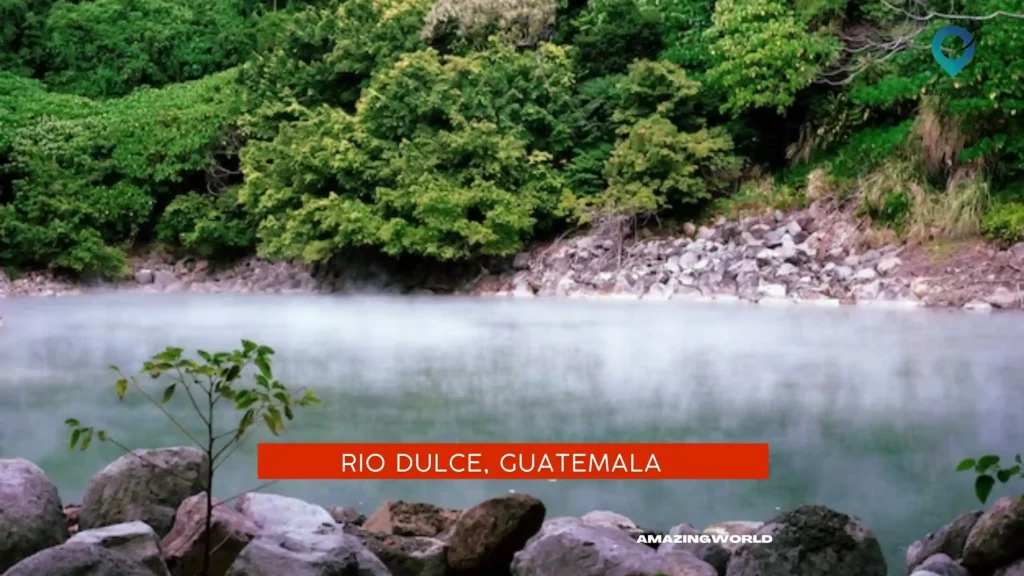
Rio Dulce, located in eastern Guatemala, is a stunning destination known for its lush jungle landscapes, meandering river, and cascading waterfalls.
The area is rich in natural beauty and diverse wildlife, making it a popular destination for nature enthusiasts and adventure seekers alike.
Location: Rio Dulce is situated in the Izabal Department of Guatemala, close to the Caribbean coast. It is located about 60 kilometers east of the city of Puerto Barrios and about 240 kilometers northeast of Guatemala City.
Known for: Rio Dulce is known for its picturesque river, which winds its way through lush rainforest, providing an idyllic backdrop for boat tours, kayaking, and fishing.
The area is also home to several impressive waterfalls, including the impressive 14-meter-high waterfall at the Rio Dulce National Park.
The best mode of transportation: The best way to explore Rio Dulce is by boat, as many of the area’s most scenic spots are only accessible by water.
Alternatively, you can rent a car or take a bus to explore the surrounding areas.
Daily Budget: The daily budget for Rio Dulce ranges from $25 to $50 USD, depending on your accommodation and food choices.
Budget accommodations and local eateries are available, as well as more upscale options for those looking for a more luxurious experience.
Culture: Rio Dulce is home to a diverse mix of cultures, including the indigenous Q’eqchi’ Maya people, Garifuna, and Ladinos.
Visitors can experience traditional music, dance, and food while learning about the area’s unique cultural heritage.
Nightlife: Rio Dulce is a relatively quiet destination, with a focus on nature and outdoor activities.
While there are some bars and restaurants in the area, the nightlife is generally limited to low-key evening entertainment.
Food:The local cuisine in Rio Dulce is a blend of indigenous and Caribbean flavors, with fresh seafood, plantains, and coconut featuring prominently in many dishes.
Traditional Guatemalan cuisine is also available, including hearty stews and soups.
Safety measures: While Rio Dulce is generally considered safe, it’s always important to take precautions when traveling in unfamiliar areas.
Avoid carrying large sums of cash, stay in well-lit areas at night, and be aware of your surroundings.
Attractions: Some of the top attractions in Rio Dulce include the Rio Dulce National Park, the waterfalls at Finca Paraiso, and the historic Castillo de San Felipe, a 17th-century fort that served as a stronghold against pirates.
Some travel tips:
- Bring plenty of bug spray and sunscreen, as the area can be quite humid and buggy.
- Book a boat tour to explore the river and see some of the area’s hidden gems.
- Consider visiting during the off-season to avoid crowds and save money on accommodations.
- If you’re interested in hiking, bring sturdy shoes and prepare for some steep climbs to reach some of the waterfalls and scenic viewpoints.
27. Placencia, Belize – Beaches & Relaxation.
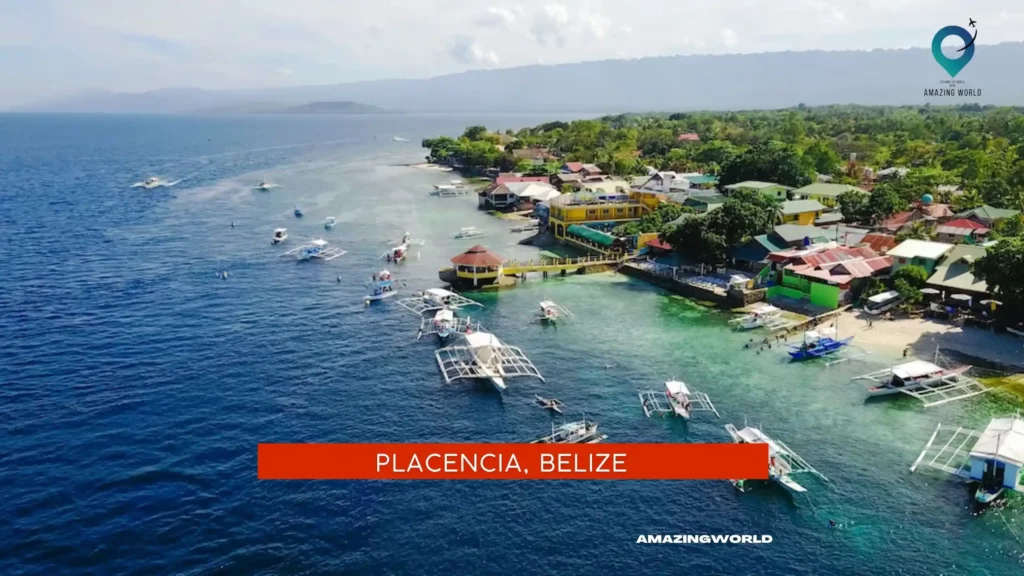
Placencia, located on the southeastern coast of Belize, is a small town known for its laid-back Caribbean vibe and stunning beaches.
It is a perfect destination for those seeking relaxation, water activities, and some local charm.
Location: Placencia is located in the Stann Creek District of Belize, on a narrow 16-mile-long peninsula that separates the Caribbean Sea from the Placencia Lagoon.
Known for: Placencia is known for its pristine white sandy beaches, crystal clear waters, and coral reefs, making it an ideal destination for water activities such as snorkeling, diving, and fishing.
The town is also home to several bars and restaurants serving up delicious seafood, as well as a vibrant local arts scene.
The best mode of transportation: The best way to get around Placencia is by foot, bike, or golf cart.
The town is small and easily walkable, but renting a bike or golf cart can give you more freedom to explore the surrounding areas.
Daily Budget: A daily budget for Placencia can vary depending on your travel style, but on average, you can expect to spend around $50-100 USD per day.
This includes accommodation, food, and activities.
Culture: Placencia has a rich mix of cultures, including the Garifuna people who have their own unique language, music, and dance.
Visitors can experience the vibrant local culture through traditional drumming and dancing performances, as well as exploring the local arts and crafts scene.
Nightlife: The nightlife in Placencia is relatively low-key, with most bars and restaurants closing early.
However, there are a few places to enjoy a drink and some live music, especially on weekends.
Food: Placencia is known for its seafood, and there are plenty of restaurants serving up fresh catches of the day. Other local specialties include rice and beans, fry jacks, and garnaches.
Safety measures: Placencia is generally a safe place to visit, but it is always important to take precautions such as not leaving valuables unattended and being aware of your surroundings, especially at night.
Attractions: The main attraction in Placencia is the beach, where visitors can sunbathe, swim, and enjoy water sports.
Other popular activities include snorkeling and diving in the nearby coral reefs, visiting the local Mayan ruins, and exploring the Cockscomb Basin Wildlife Sanctuary.
Some travel tips:
- Pack light, as the weather is warm and casual attire is suitable
- Make sure to bring sunscreen and insect repellent
- Book tours and activities in advance to ensure availability
- Try the local seafood, it’s delicious!
- Take a water taxi to nearby islands for even more beach and snorkeling options.
28. Samara, Costa Rica – Surfing & Pura Vida Lifestyle.

Located on the Pacific Coast of Costa Rica, Samara is a picturesque beach town known for its laid-back Pura Vida lifestyle and world-class surfing.
With its stunning beaches, excellent surfing conditions, and relaxed vibe, Samara has become a popular destination for surfers, backpackers, and travelers looking to soak up some sun and experience the local culture.
Location: Samara is located on the west coast of Costa Rica, in the province of Guanacaste, about 35 km south of Nicoya.
Known for: Samara is known for its beautiful beaches, excellent surfing conditions, and relaxed Pura Vida lifestyle.
The town is also home to a vibrant local community, with a variety of restaurants, cafes, and shops selling locally made crafts and souvenirs.
The best mode of transportation: The easiest way to get to Samara is by car, although there are also regular bus services from nearby towns and cities.
Once you’re in town, it’s easy to get around on foot or by bicycle, and there are plenty of taxis available if you need them.
Daily Budget: Samara is a relatively affordable destination, with plenty of budget-friendly accommodation options, restaurants, and activities.
Expect to spend around $30-50 per day on food and accommodation, with additional costs for activities like surfing lessons and tours.
Culture: Samara has a laid-back, beach town vibe, with a strong emphasis on the Pura Vida lifestyle.
The town is home to a mix of locals and expats, and there is a strong sense of community and hospitality here.
Nightlife: Samara is not known for its nightlife, but there are a few bars and clubs where you can enjoy a drink or two. Most of the action in Samara takes place during the day, with plenty of outdoor activities and beach parties to keep you busy.
Food: Samara is home to a wide range of restaurants and cafes serving up local and international cuisine.
Some popular dishes to try include ceviche, fresh seafood, and traditional Costa Rican rice and beans.
Safety measures: Samara is generally a safe destination for travelers, but it’s always a good idea to take basic safety precautions like locking up valuables and staying aware of your surroundings, especially after dark.
Attractions: The main attraction in Samara is the beach, which stretches for several kilometers and is perfect for swimming, sunbathing, and surfing.
Other popular activities in Samara include hiking, horseback riding, and snorkeling.
Some travel tips:
- Be sure to pack plenty of sunscreens and insect repellent, as the sun and bugs can be intense in Samara.
- If you’re planning to surf, consider taking a lesson with one of the local surf schools to get the most out of your experience.
- Take some time to explore the nearby town of Nosara, which is known for its yoga and wellness scene.
29. Rojo Lagoon, Guatemala – Hidden Gem & Hiking Trails.
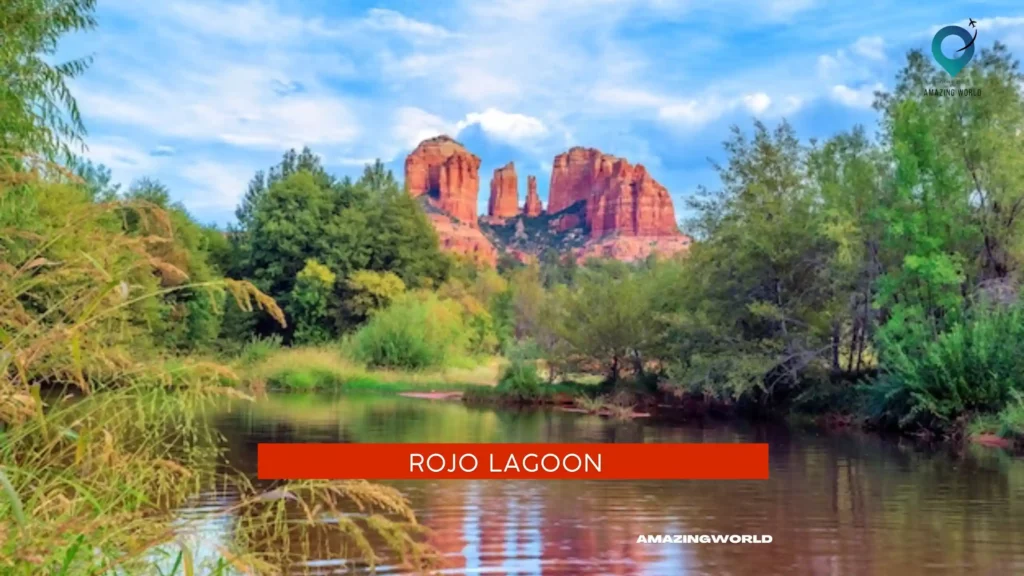
Rojo Lagoon is a hidden gem in Guatemala known for its crystal-clear waters, scenic hiking trails, and breathtaking views.
It is located in the municipality of Santa Cruz La Laguna, in the Sololá Department, and is a popular destination for nature enthusiasts.
Location: Rojo Lagoon is located in the highlands of Guatemala, approximately 3 hours by car from Guatemala City.
It is situated in the municipality of Santa Cruz La Laguna, on the shores of Lake Atitlán.
Known for: Rojo Lagoon is known for its pristine waters, which are fed by natural springs and surrounded by lush vegetation.
The lagoon is also famous for its hiking trails, which offer stunning views of Lake Atitlán and the surrounding volcanoes.
The best mode of transportation: The best way to reach Rojo Lagoon is by car or by hiring a private shuttle from Guatemala City or Antigua.
Alternatively, you can take a public bus to Panajachel and then a boat to Santa Cruz La Laguna, followed by a short hike to the lagoon.
Daily Budget: The daily budget for Rojo Lagoon will vary depending on the type of accommodation you choose and your preferred activities.
Budget options include camping, hostels, and guesthouses, while mid-range and luxury options are also available.
Culture: Rojo Lagoon is located in an indigenous community, and visitors are encouraged to respect the local culture and traditions. Traditional Mayan textiles and handicrafts are available for purchase in the nearby village.
Nightlife: Rojo Lagoon is a quiet and peaceful destination, with limited nightlife options. However, there are several bars and restaurants in the nearby village of Santa Cruz La Laguna.
Food: Traditional Guatemalan cuisine is available at the local restaurants near Rojo Lagoon, with fresh fish and seafood being a specialty. Vegetarian and vegan options are also available.
Safety measures: Visitors should be aware of the high altitude and take precautions to prevent altitude sickness.
It is also important to stay hydrated and wear sunscreen, as the sun can be intense at this altitude.
Attractions:
The main attraction at Rojo Lagoon is the crystal-clear water, which is perfect for swimming and snorkeling.
There are also several hiking trails in the area, which offer stunning views of the lake and the surrounding volcanoes.
Some travel tips:
- Bring comfortable shoes for hiking
- Pack warm clothing for the high altitude
- Respect the local culture and traditions
- Bring sunscreen and insect repellent
- Stay hydrated and be mindful of altitude sickness symptoms.
How much did you like Our detailed 25 Best Destinations in North America for Solo Travelers? Review Also, please share these Blogs with your friends on social media.
Recommended
- Best Countries to Visit as Solo Travelers
- 25 Best Countries to Visit as Solo Travelers in 2023
- Best Places In Asia for Solo Travelers
- Best Destinations in Africa for Solo Travelers
- Best Destinations on Caribbean Island
- Best Destinations in North America
Best Destinations in Central America Locations
Best Destinations in Central America FAQ’S
What is the best time of year to visit Central America?
The dry season, from December to April, is generally the best time to visit Central America.
Is Central America safe for tourists?
Central America is generally safe for tourists, but it is important to take precautions and be aware of your surroundings.
What are the must-see attractions in Central America?
Some of the must-see attractions in Central America include the Mayan ruins, beaches, volcanoes, jungles, and colonial cities.
What are the best activities to do in Central America?
Some of the best activities to do in Central America include hiking, surfing, snorkeling, scuba diving, zip-lining, and exploring the local culture and cuisine.
What is the currency used in Central America?
The currency used in Central America varies by country, but the most commonly used currencies are the US dollar and the local currency.
Do I need a visa to travel to Central America?
The visa requirements for Central America vary by country and your country of origin. It is best to check with the embassy or consulate of the country you plan to visit for specific visa requirements.
What is the official language spoken in Central America?
The official language spoken in Central America varies by country, but the most commonly spoken language is Spanish.
How do I get around Central America?
The best way to get around Central America is by bus, shuttle, or taxi. Domestic flights are also available, but they can be more expensive.
What is the cost of living in Central America?
The cost of living in Central America varies by country and region, but it is generally lower than in the United States or Europe. The cost of food, accommodations, and transportation is relatively affordable.

Meet David Hoper, a passionate travel Blog writer with 7+ years of experience in travel content. Through his exemplary storytelling and engaging narratives, he shares his experiences and brings destinations to life. With a keen eye for detail and a love for exploration, he has cultivated a diverse portfolio of travel blogs that inspire and inform readers worldwide.
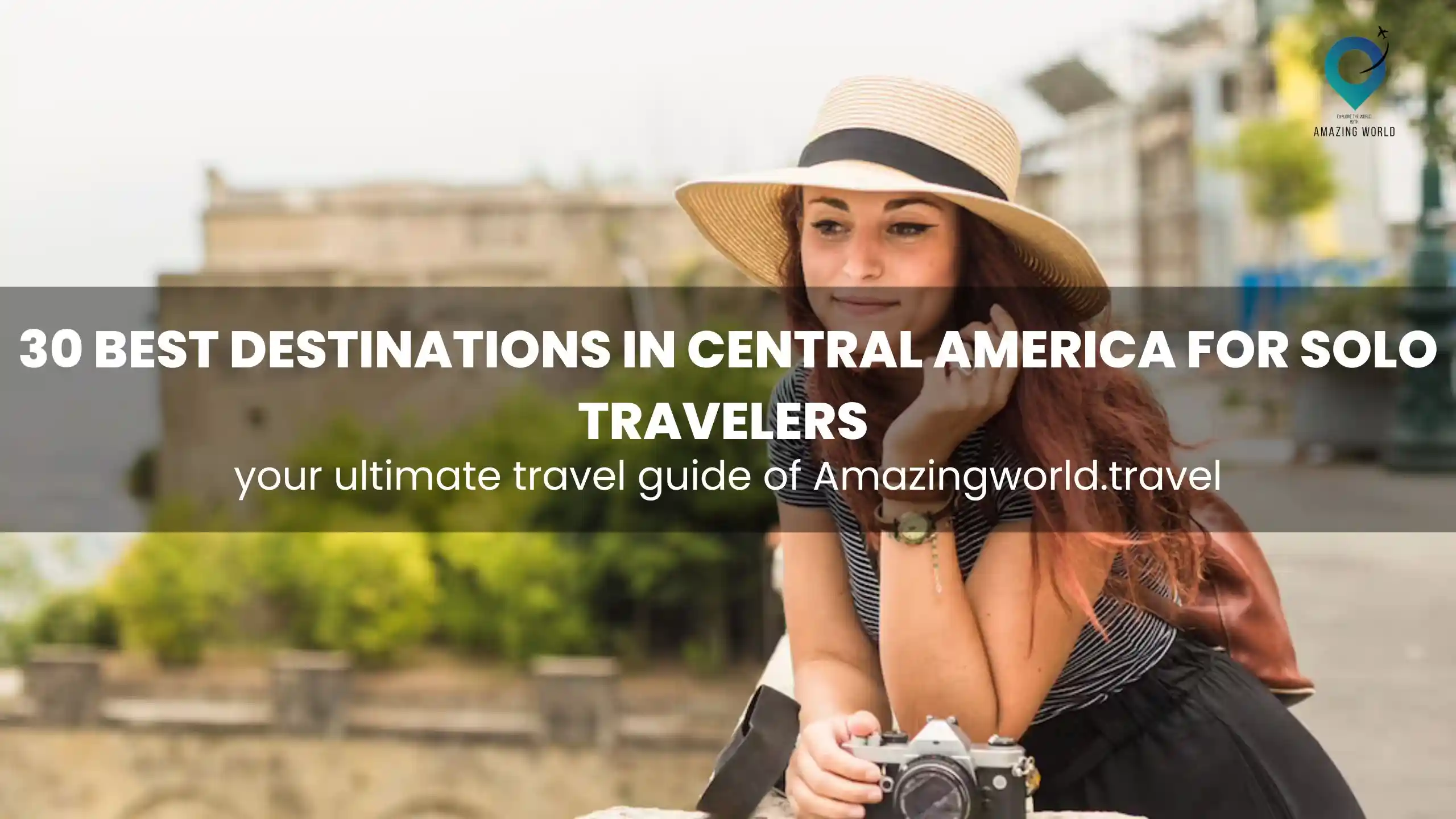
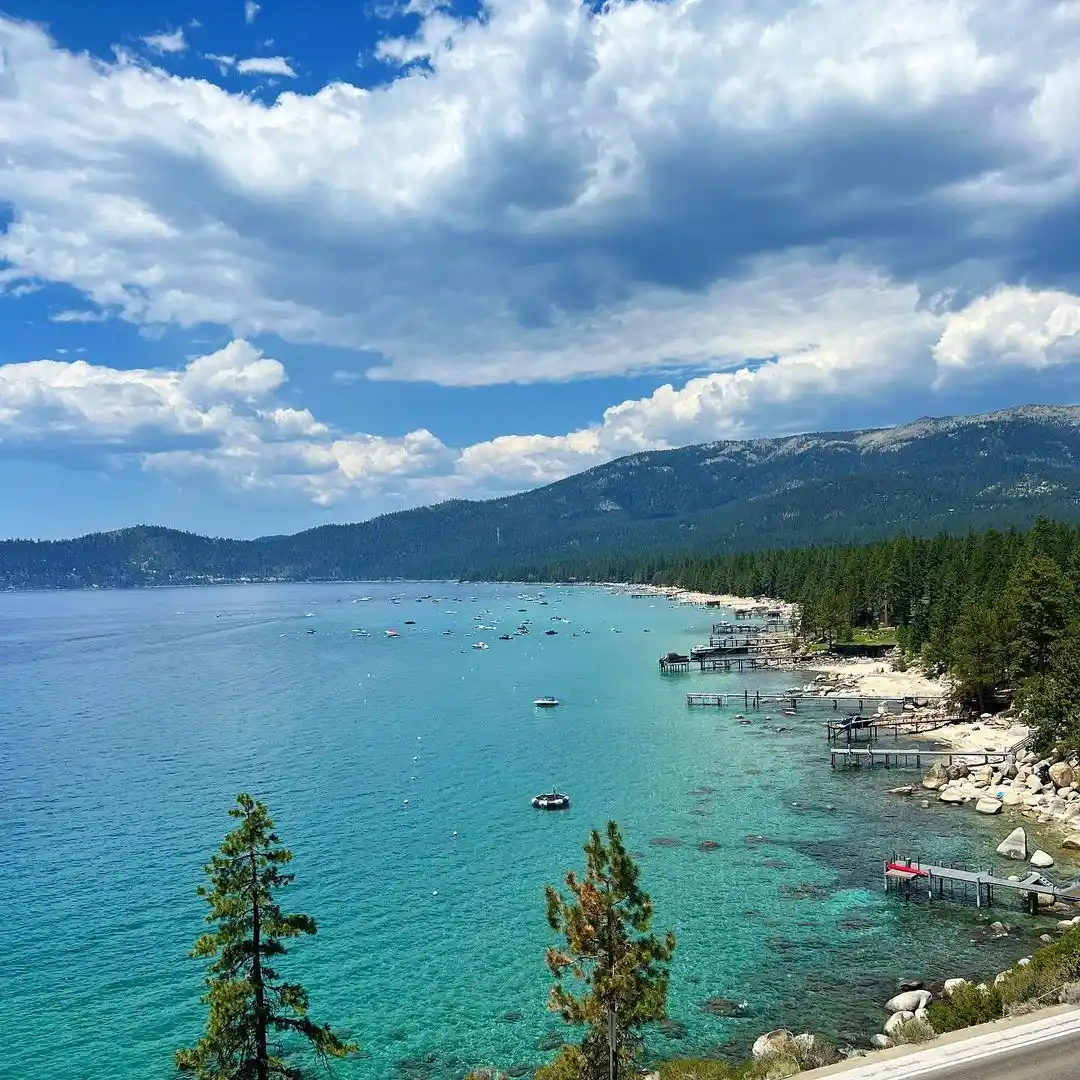
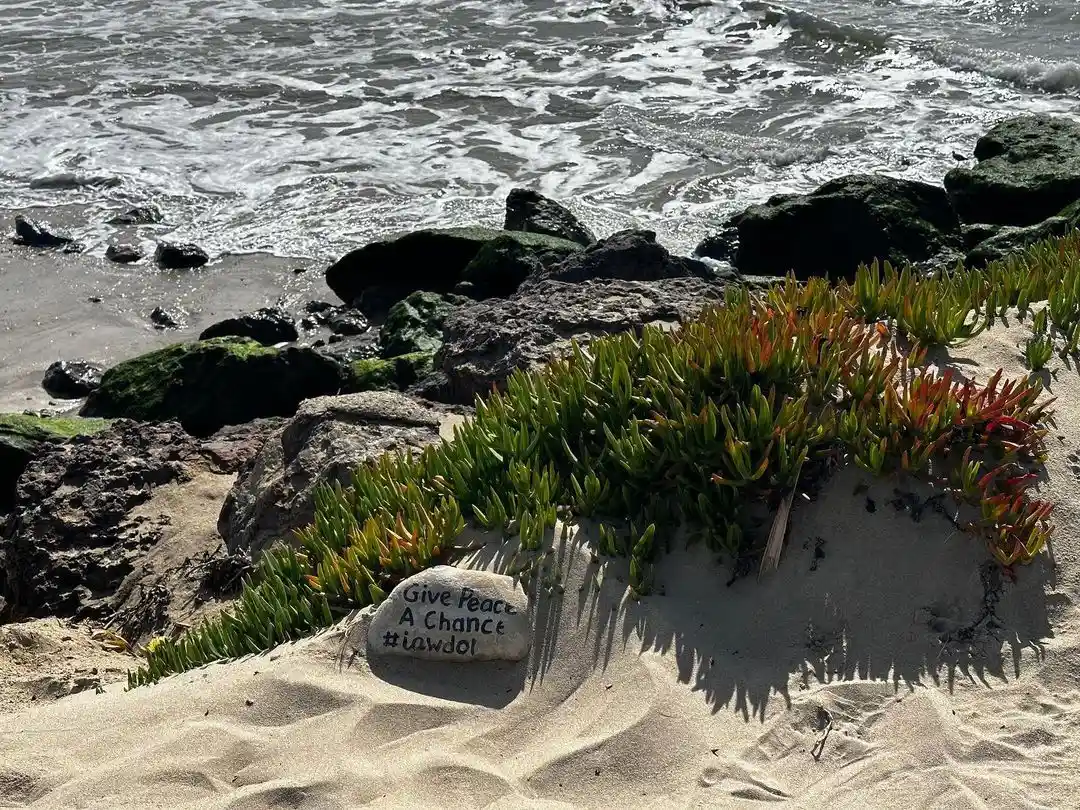
1 comment
The tips you shared on packing light and efficiently are gold! I always struggle with over-packing, but I feel better prepared for my next trip after reading this.